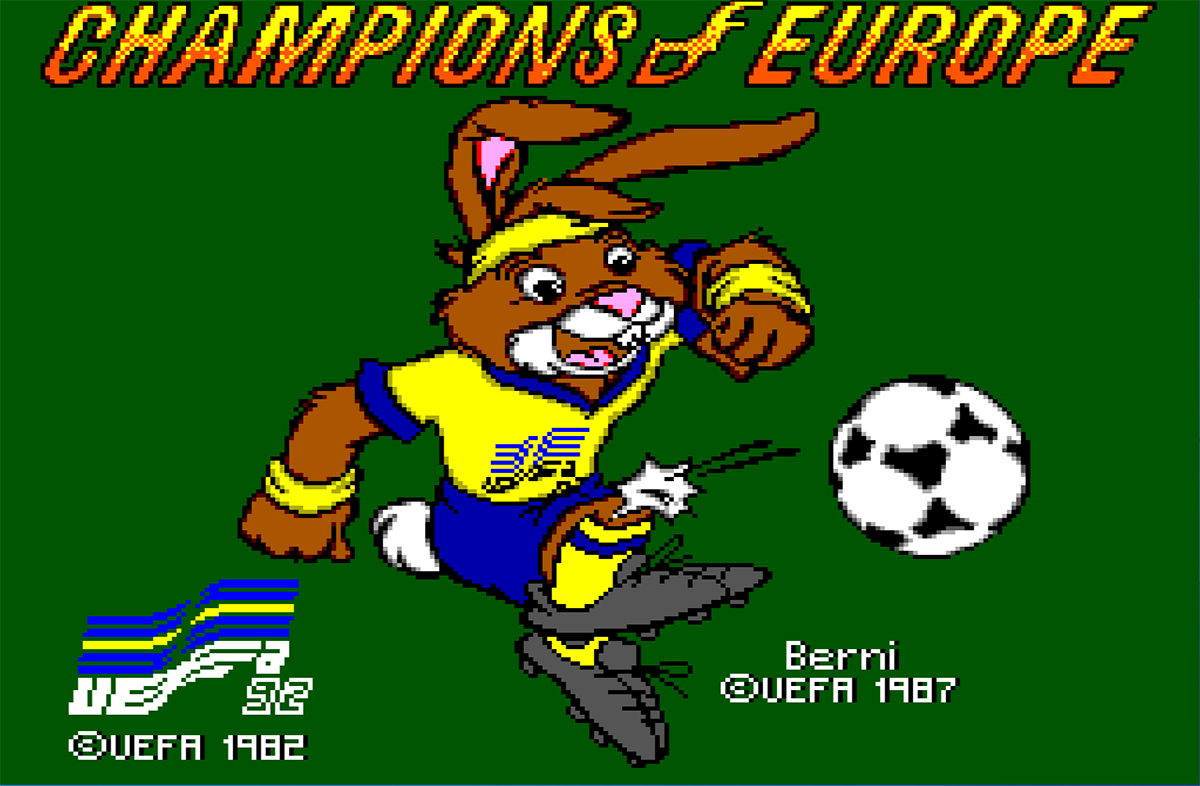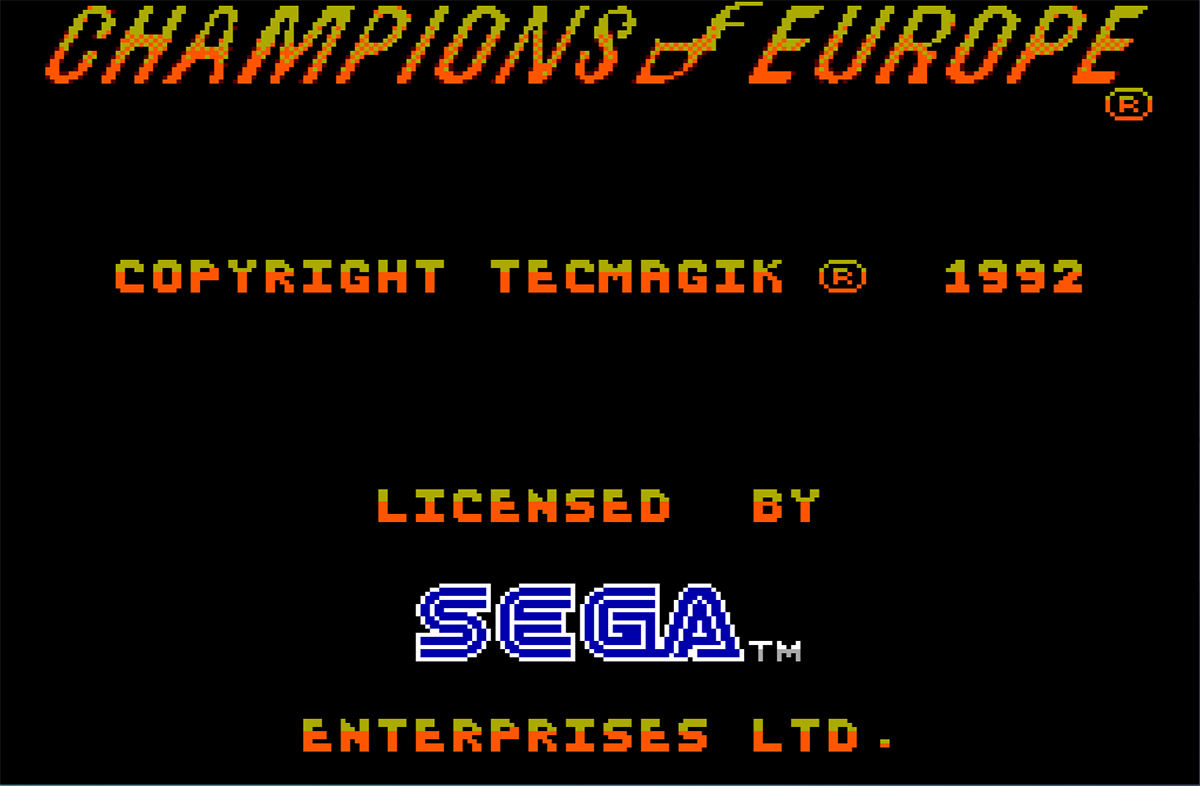
Euro 2020 is finally under way after a delay of a year due to a rather inconsiderate pandemic. This quadrennial festival of football features Europe’s finest national teams, plus Scotland.
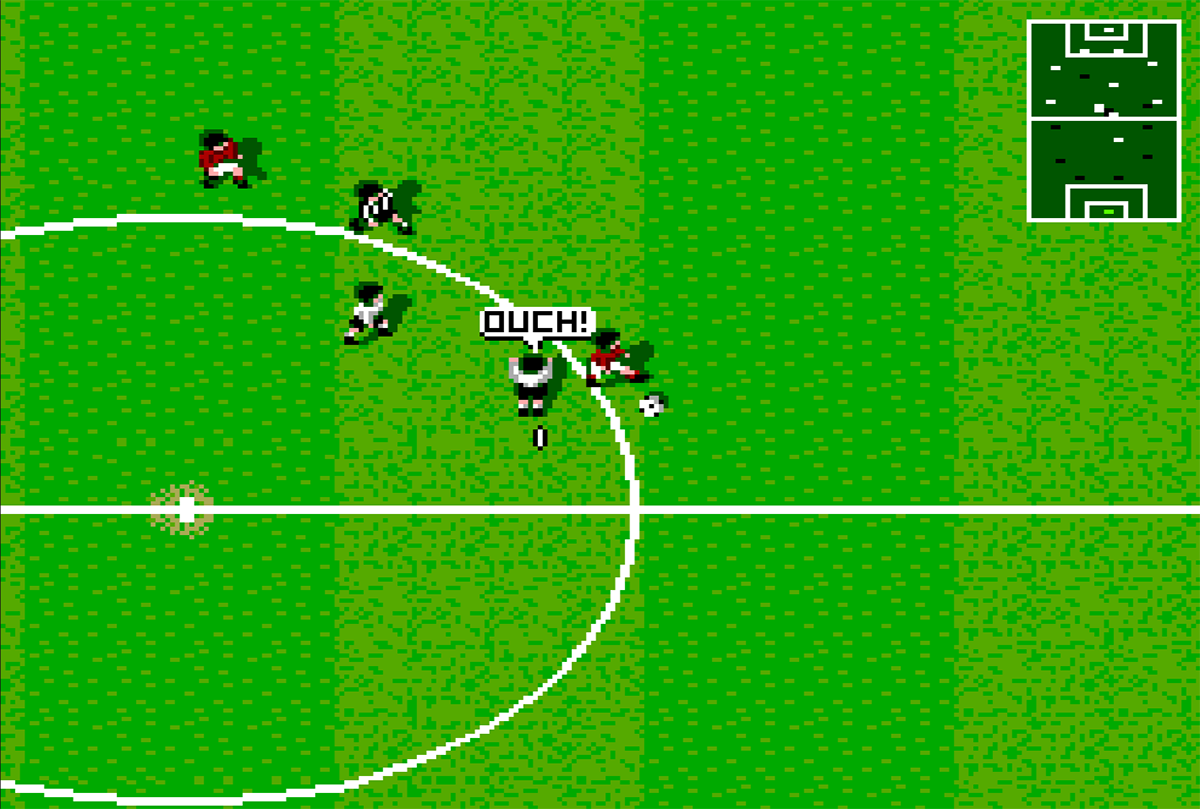
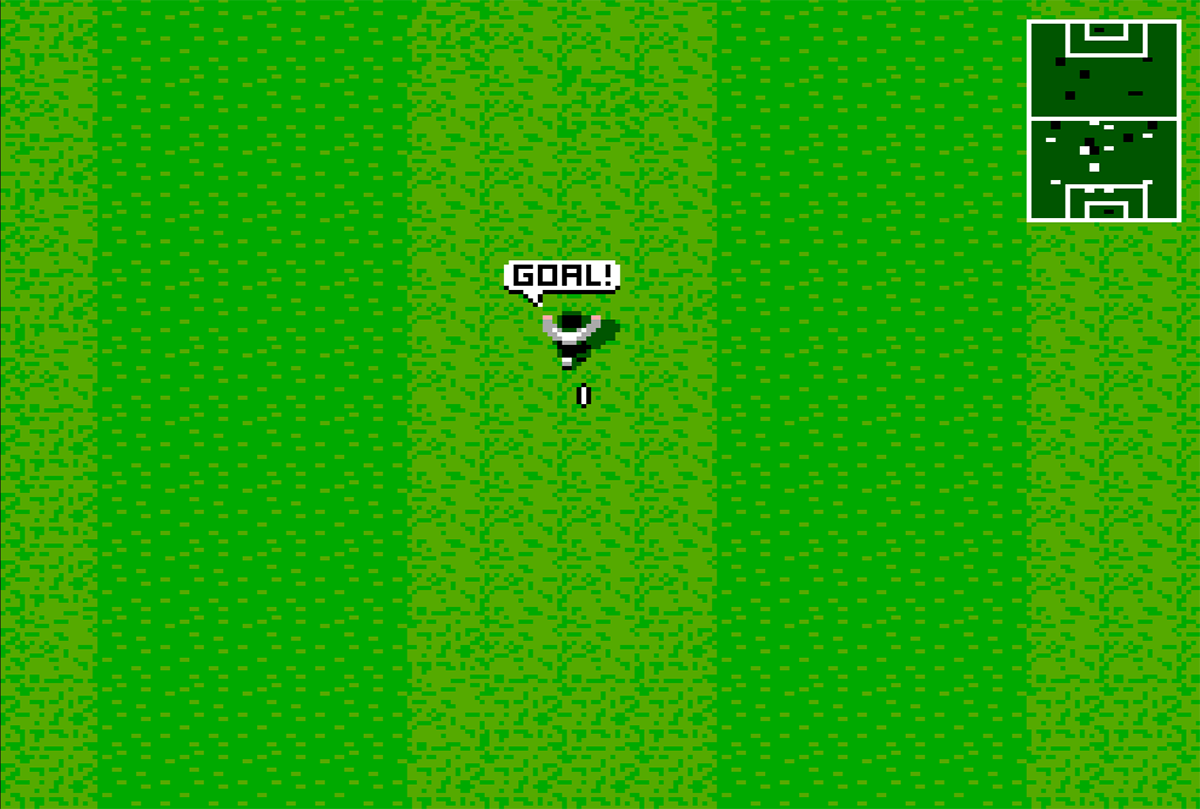
As is typical when these kinds of things come around, my invitation to represent the country appears to have got lost in the post again. Either that or I’ve not been picked to partake in a kickabout this time. Can’t blame them really. I’m crap at football. But I always like to experience the event in my own little way, and that’s by taking part in a virtual tournament. And to do so this time, I’ve picked the very first officially licensed video game of the European Championships. That game happens to be Champions of Europe for the Sega Master System.
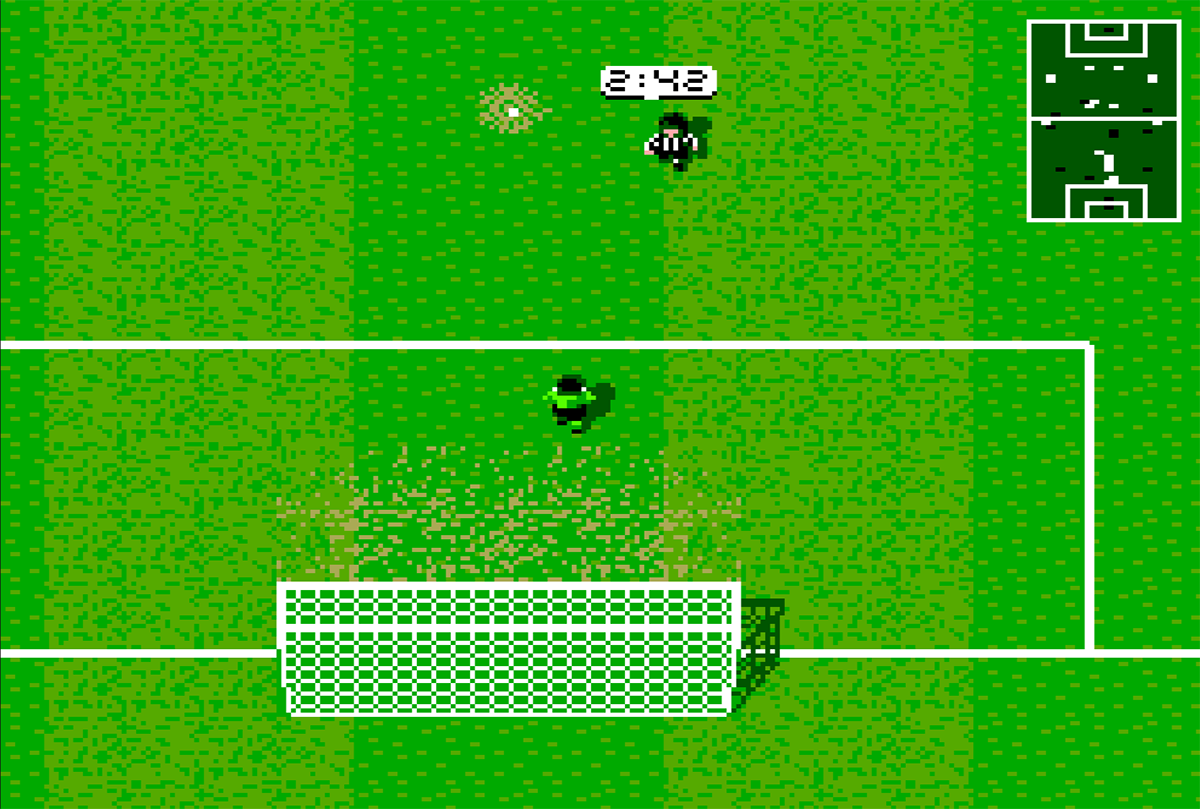
At least I think it’s the first official game. The box states that it is the “official football game of UEFA ‘92” and my half-assed attempt at research suggests that there were no official games for prior tournaments in 1988, 1984 and 1980. Wikipedia seems to think the first was Euro ’96, which was released for PCs and the Sega Saturn in 1996. So either the Master System box is lying or Wikipedia is lying. I think I’ll believe the box on this occasion.
As well as being the first official game, it was the only official game of Euro ’92. After playing it for a while though, this isn’t something that the Master System can really boast about. It truly is abysmal. Bizarrely, it seemed to review really well at the time – more on that later.
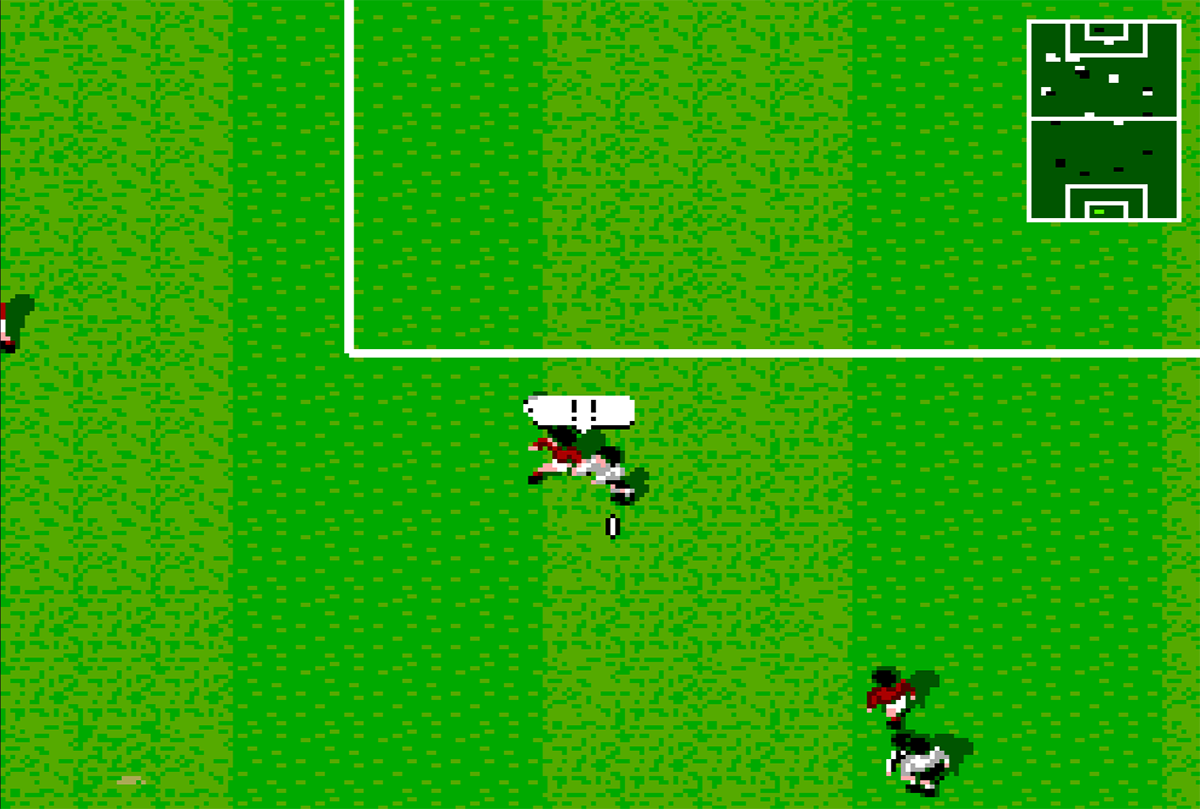
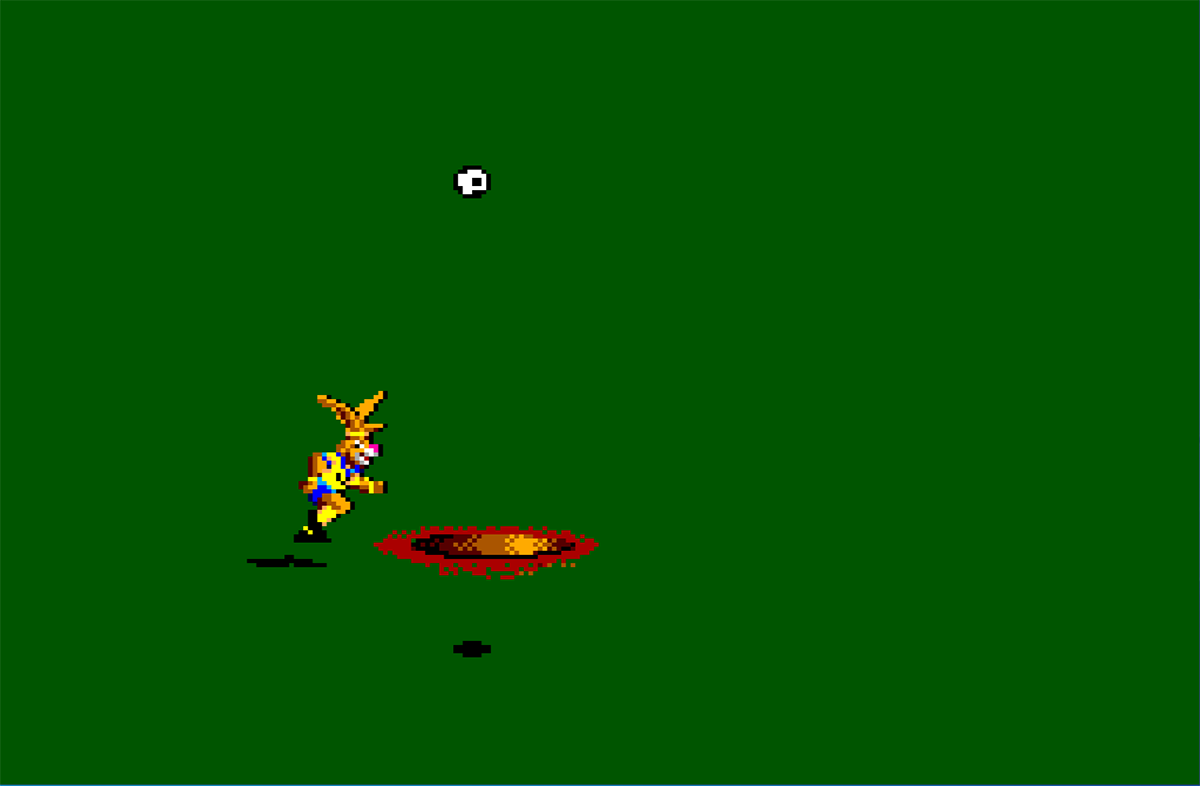
Things don’t start too badly. Berni the Bunny, the official mascot of the tournament, shows off some of his footballing skills to open the game. Returning to my half-assed research for a moment or two, apparently Berni was created as the mascot for Euro ’88, for which he was kitted out in the colours of the West German squad as they were that year’s host nation. He bears a striking resemblance to the Nesquik rabbit. It seems that the Swedes weren’t too keen on creating a new mascot when they hosted Euro ’92 so reused Berni, changed his kit colours to the blue and yellow of Ikea and renamed him Rabbit. In Champions of Europe, he is still referred to as Berni on the title screen, while the instruction manual even makes a claim that he is a Walt Disney creation. Whether this is a long forgotten piece of Disney lore that nobody knows, or whether TecMagik got their bunnies confused and thought he was Roger Rabbit, we may never know. Either way, he still looks the Nesquik rabbit. Accompanying the animation of Berni/Rabbit/Nesquik/Roger is a tune which is fairly decent, even with the high-pitched sound chip of the Master System piercing your eardrums.
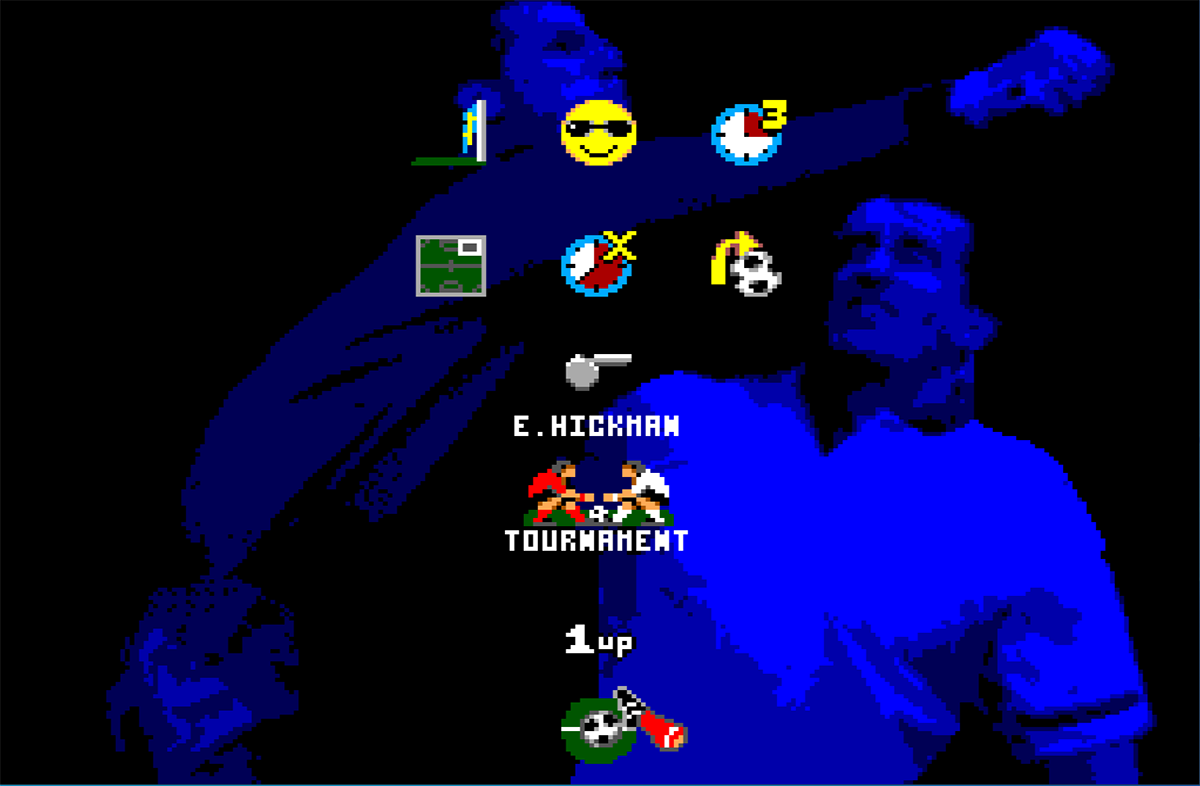
It’s then onto setting up your very own European tournament which is done through an icon-filled screen of confusion. It seems that TecMagik thought it would be a good idea to make you decipher hieroglyphics to change the match parameters. Fair enough, the little images are mostly logical and make sense, but when all you want to do is play a game of football, they’re an unnecessary hurdle. Words would be fine. A flag sets the wind speed, a smiley sun sets the weather, a clock sets the half length, a football pitch with square in its corner lets you set the position or visibility of the radar thingy, another clock lets you decide whether extra time is allowed and a ball with an arrow next to it lets you decide if curved shots are permitted. Images change depending on your choice, e.g. the sun becomes rain clouds if you want to simulate the Great British summer, and the arrow next to the ball changes shape depending on whether you want kick the ball in straight lines or to be able to bend it like Beckham. Other options let you pick the referee, as if that actually matters, choose the game mode from demo, practice, tournament and single, set the number of players and finally start the game. Demo is simply an opportunity to watch a digital football match play out before your eyes. Practice lets you practice taking penalties or have a kick around the pitch with no opposition. Tournament is your chance to take your team all the way through to the final and single lets you play just the one game and then wonder afterwards what else you could have done with the time you’ve just lost. Despite my whinge about the menu, once you know what does what, you can actually get into a game fairly quickly.
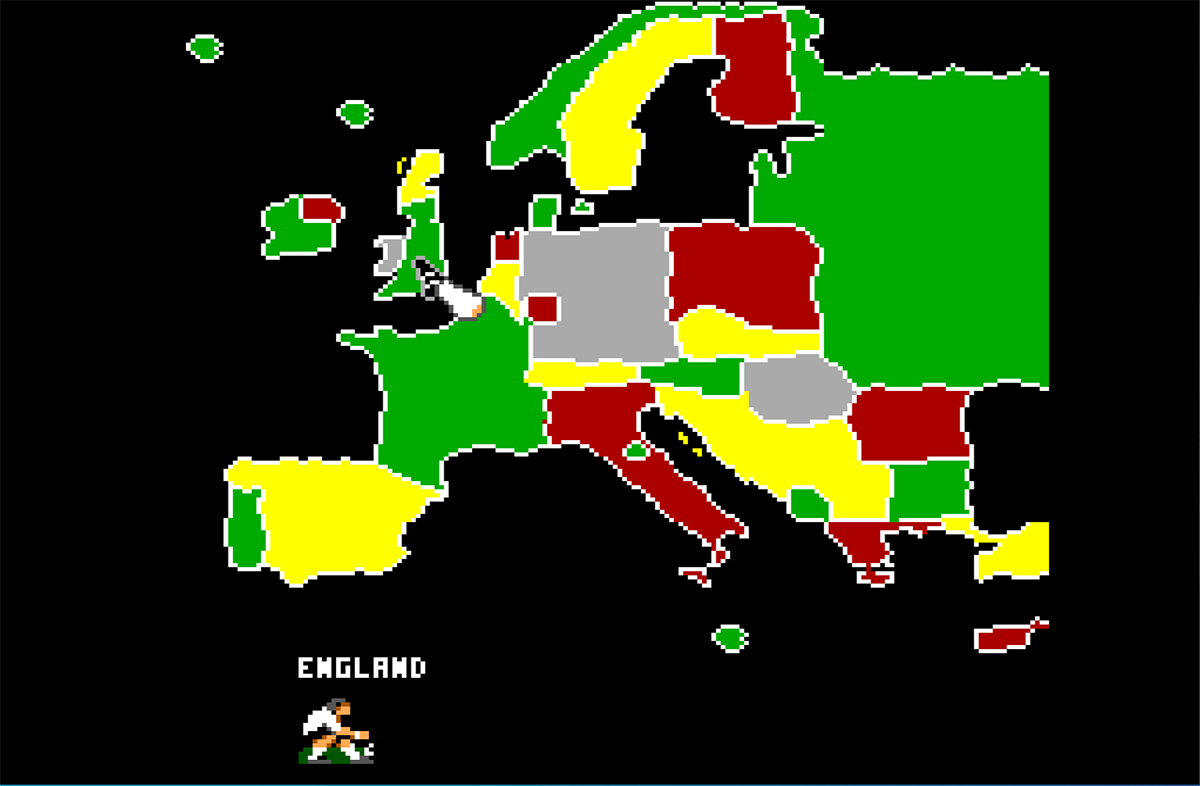
When you’ve made your choices, you’re then able to pick the teams. To do this you are transported to a map of Europe which appears to have been illustrated by a six year old. Slightly confusing at first is that each country’s name is written in the way it is spelled natively. So Norway is Norge, Wales is Cymru, and Shqiperia is, um, the country next to Hellas. Ooooh, apparently people from Finland call their own country Suomi. Well, if anything, it’s educational. It’s quite a nice touch in a way, and I guess this, plus the icon-based menu screen, was a way of localising the game to all localities without actually needing to localise it. Clever.
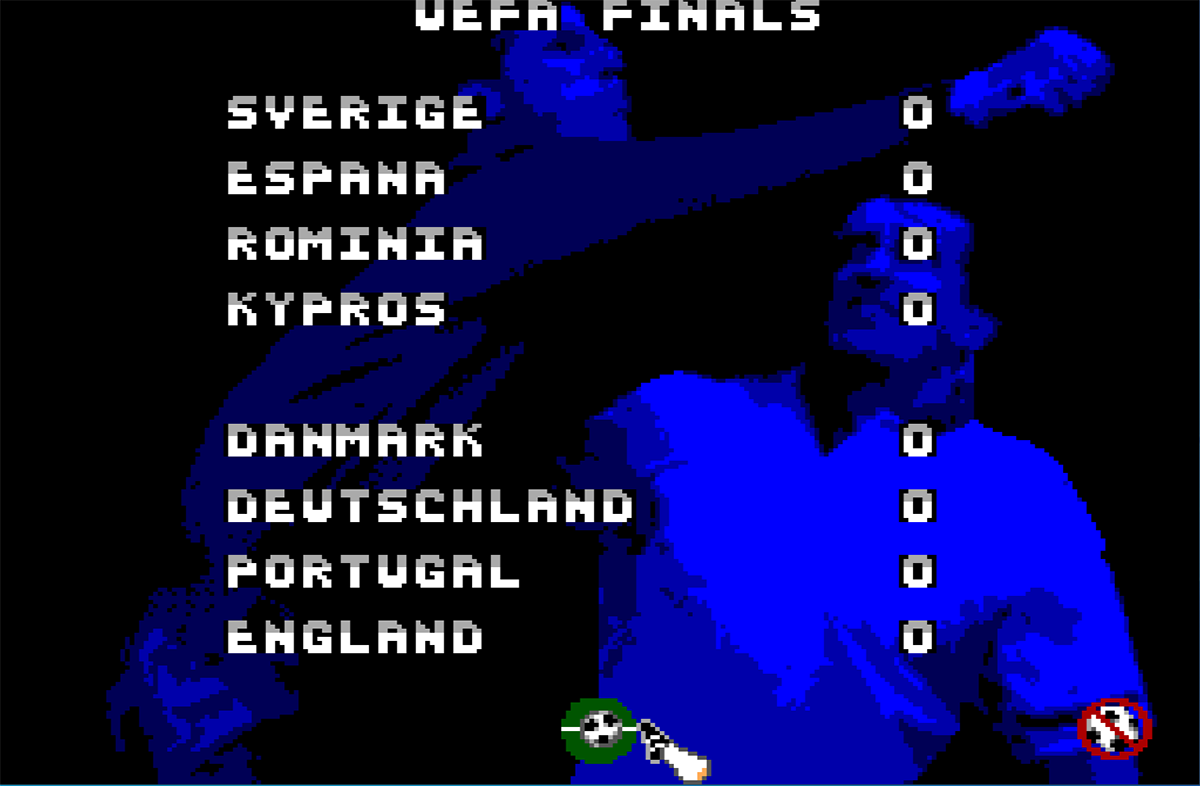
When the finals of the real Euro ’92 tournament took place, it featured only eight teams. These were split into two groups of four with group members playing each other once, so teams were guaranteed at least three games. Unlike today where a win earns three points, back then it earned two. The top two teams from the groups qualified, with the winners of each group playing the runners up of the other in the semi-finals. And the winners of those went through to the final. This format is followed closely in Champions of Europe, although, as you can choose from 34 European countries, the eight teams in the finals aren’t necessarily going to be the ones that were in it in real life. Interestingly, one of the countries that did qualify back in 1992 was Yugoslavia. However, by the time the tournament took place, it was in all kinds of turmoil and were disqualified from taking part. Denmark took its place and went on to win the whole thing. Quite remarkable. Yugoslavia are still present in the game though.
So settings set, countries picked, and finally we have a match. And this is where it’s probably best to switch the game off. Just about everything is wrong with it. The game is an overhead affair in the style of games like Kick Off and Sensible Soccer. Like Kick Off, the ball doesn’t stick to your feet, but instead rolls onwards as you kick it around the pitch while you’re running. Unlike Kick Off, in particular Kick Off 2/Super Kick Off, where mastering this skill led to a joyful and fun experience, in Champions of Europe, you only need to run up to the ball and it goes shooting forward away from you into empty space.
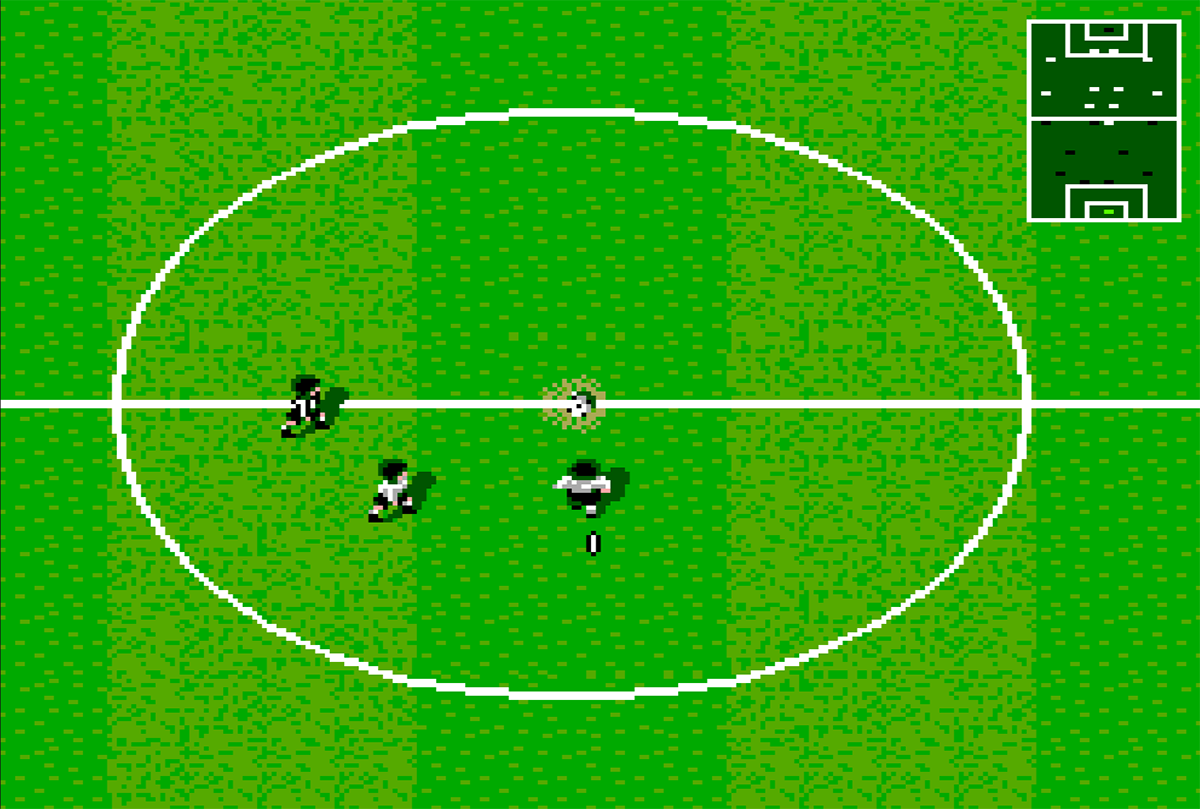
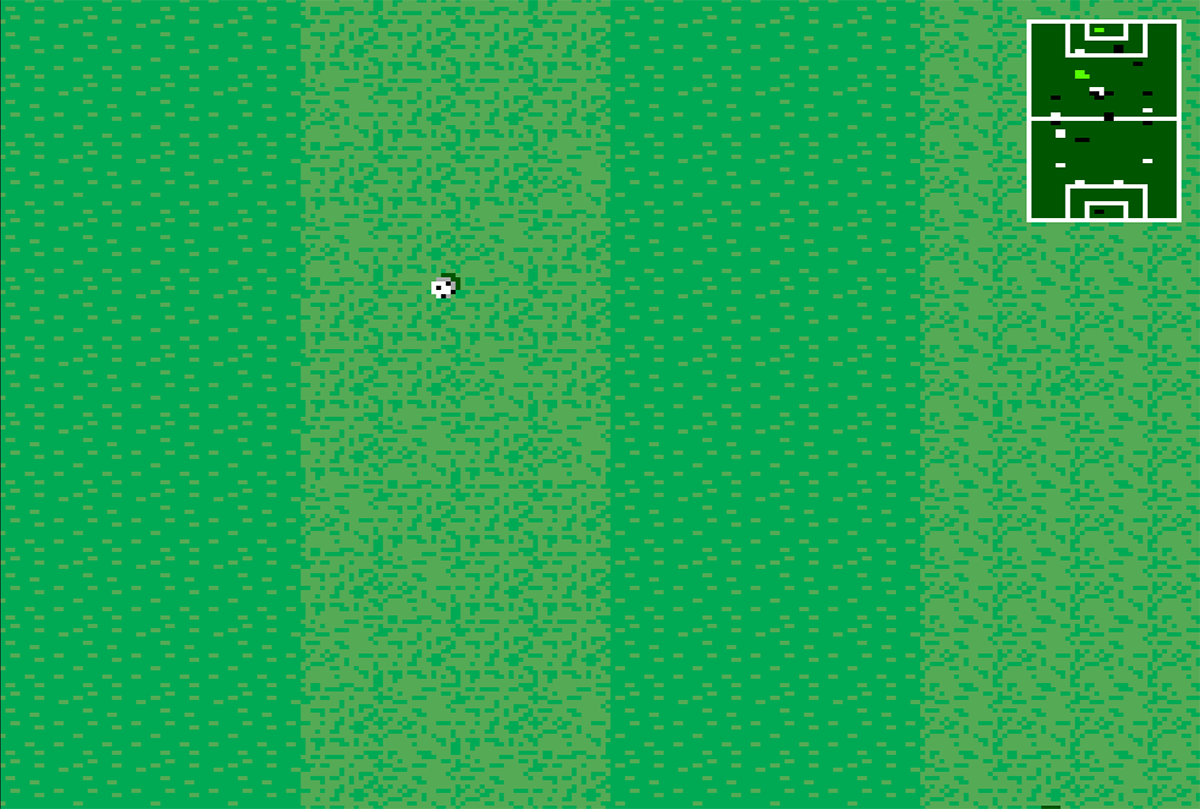
If you’re lucky, one of your teammates may be in the vicinity of that empty space but again, when he runs up to the ball, he’ll just knock it a million miles away into another empty space. Yep, the pitch is a ridiculous size, probably roughly about as large as a small country. This results in the players being spaced around everywhere so if you do want to attempt a pass, you have no idea who is where. It really is a case of kick and hope. Sometimes you get lucky and another of your teammates happens to be nearby. Other times, it’s just some opposition players. They’ll take control of the ball and as you have no idea where any of your players have wandered off to, it’s best just to wait until your opponent heads somewhere where you may spot one so you can take control of him. On the rare occasions that you do manage to go on a run up the pitch with the ball somehow staying fairly near to you, by the time you’re nearing the end of your cross country jaunt and are trying to figure out where you are in relation to the goal, you’re likely to kick the ball out of play or trip over another opponent, rendering your whole marathon pointless.
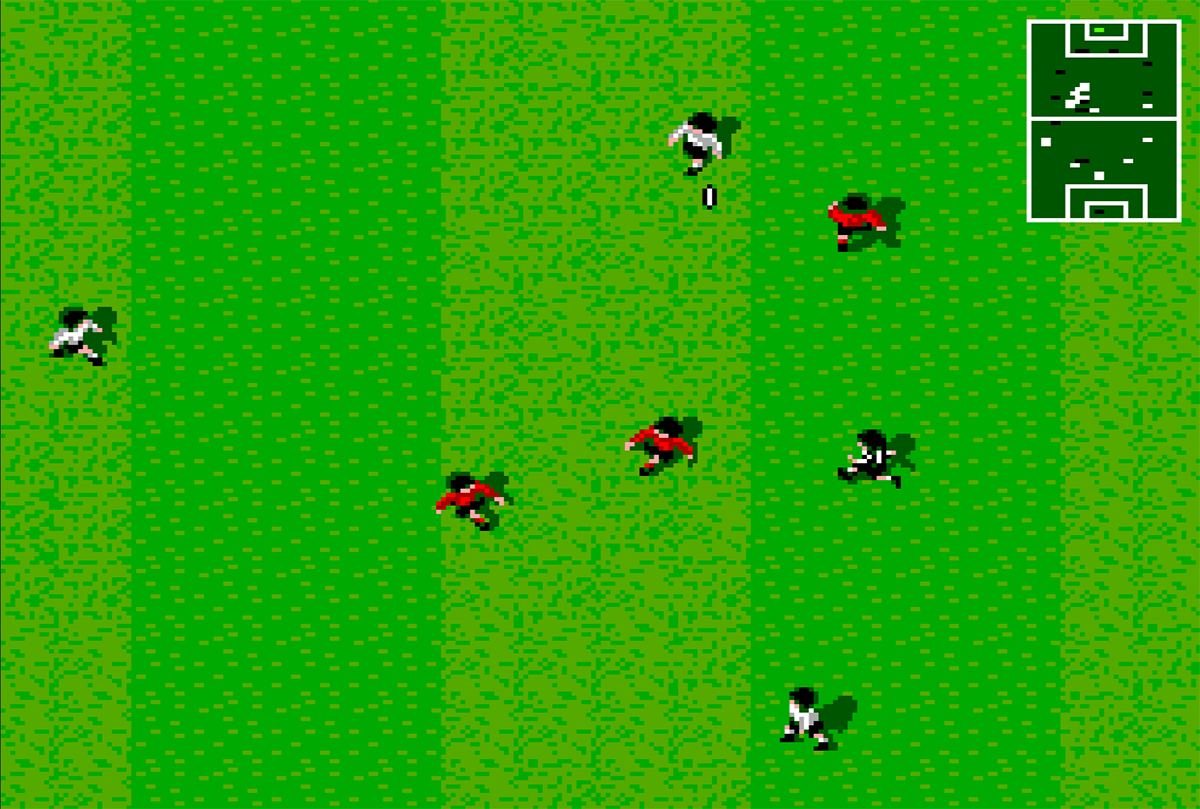
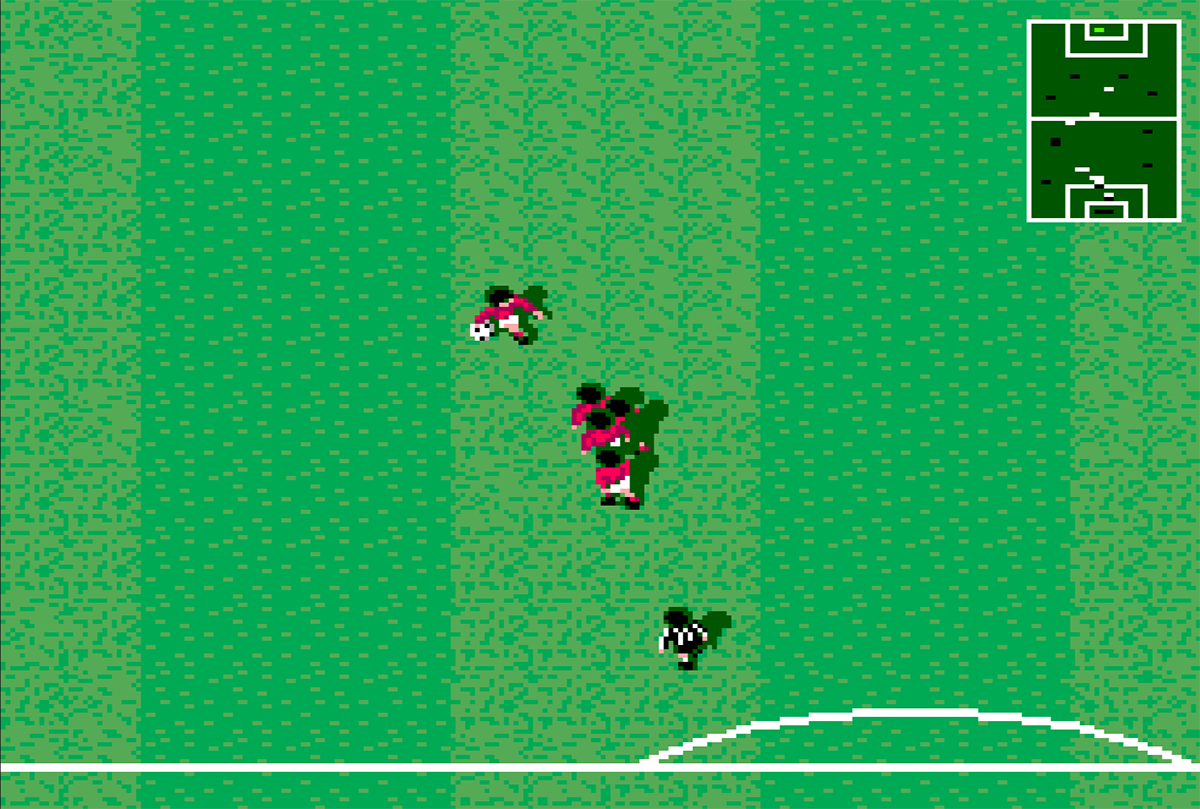
The controls are atrocious, some of the worst I’ve ever used in a football sim, or any game in general for that matter. According to the game’s manual, “TecMagik have developed an ‘instinctive’ control method that enhances both realism and playability.” The quotation marks around “instinctive” are unintentionally ironic. Or possibly TecMagik knew that the game’s controls were broken, but seeing as they needed to get the game out before the tournament began (unlike this review which is over two weeks late!), decided not to fix them and just claimed that they’re instinctive instead. Basically, if you can’t play the game, it’s because you don’t understand their amazing controls. Nothing at all to do with the fact that they’re not fit for purpose. Saying that, the manual for the Master System version of Super Kick Off also describes its controls as “instinctive” in quotes, although reality isn’t being stretched quite as much for that game. So maybe TecMagik were just attempting to copy Super Kick Off, manual and all.
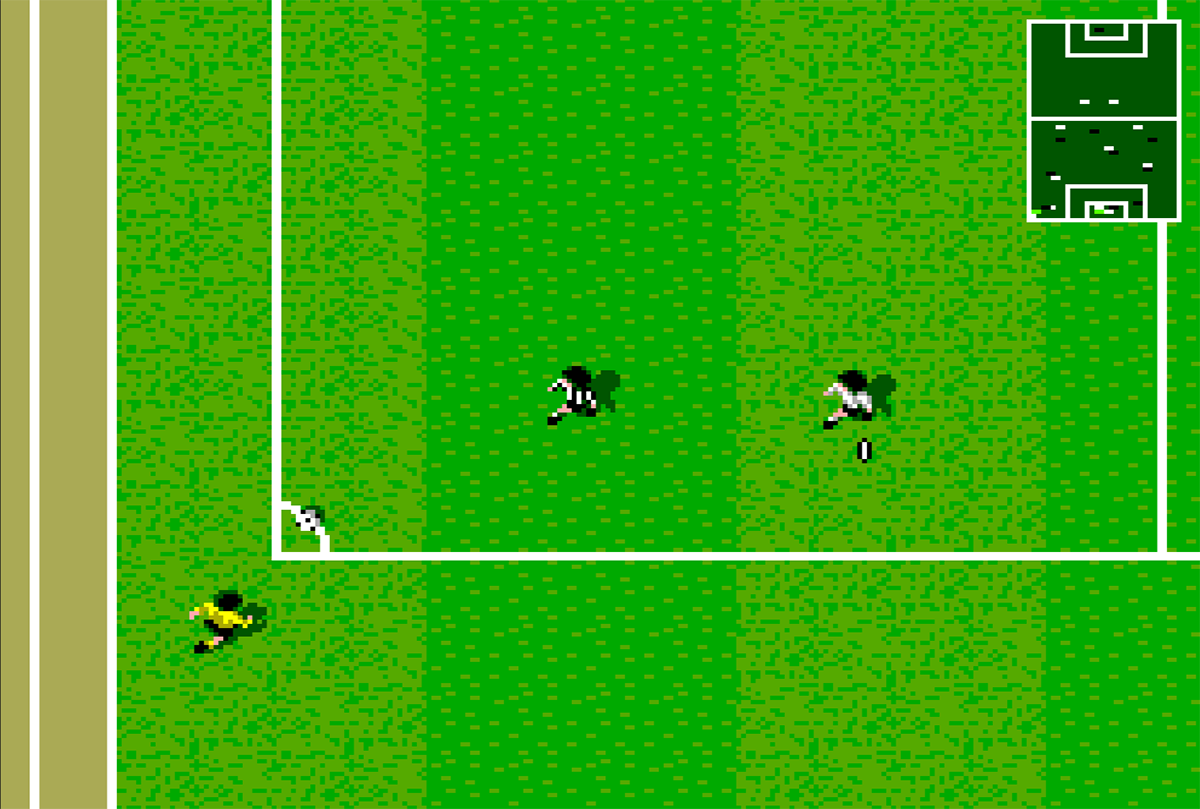
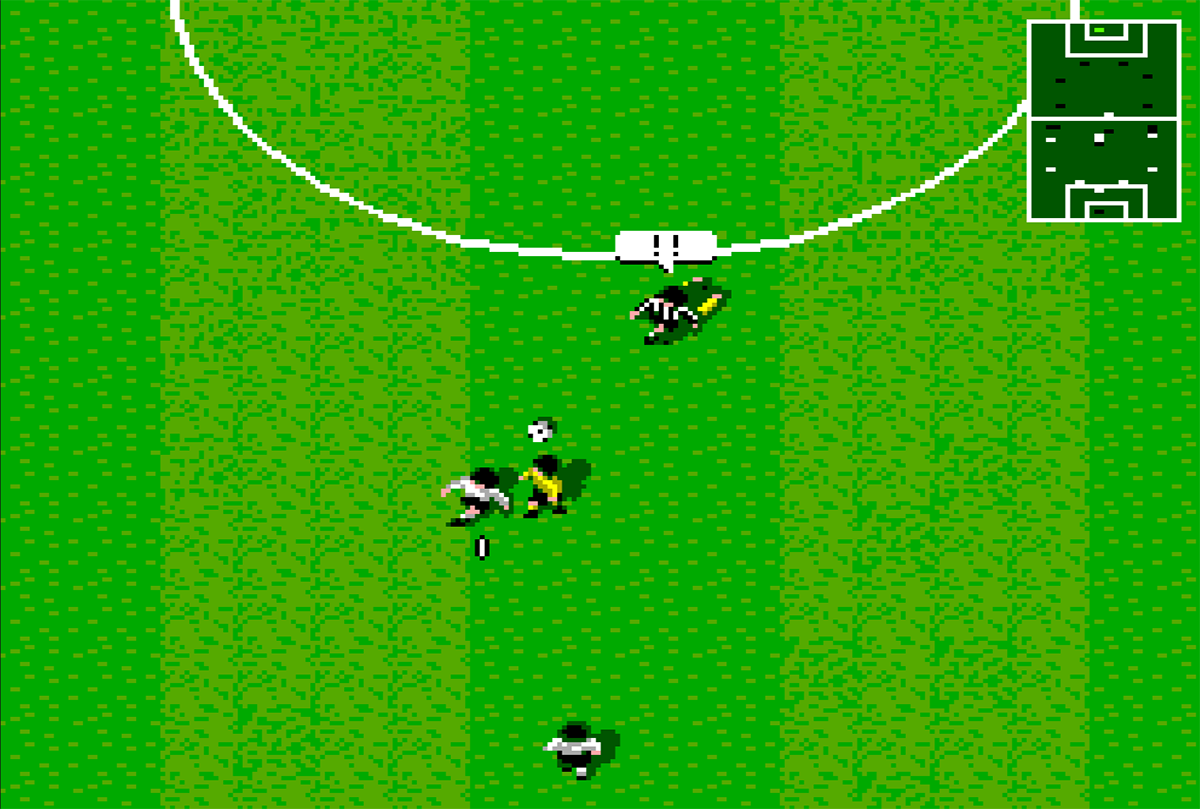
The instruction manual for Champions of Europe also goes on to mention that the “ball travels ahead of the player as it would in a real game and requires skill to control both dribbling and tackling.” But there’s just no way to dribble. It’s meant to be done by controlling your running speed, but it really has no effect. The ball still decides it wants nothing to do with you and goes off on its own adventure. If you hold button 1 when you have the ball, the player stops in his spot, traps the ball, and can then spin around to alter his direction. You can then pass or shoot the ball in his new found direction, which is still pointless as there will still be no other player in his vicinity. And passing the ball is nigh on impossible. You’re not going to be able to play passy ball between defenders and midfielders like the real England team spend the majority of their matches doing.
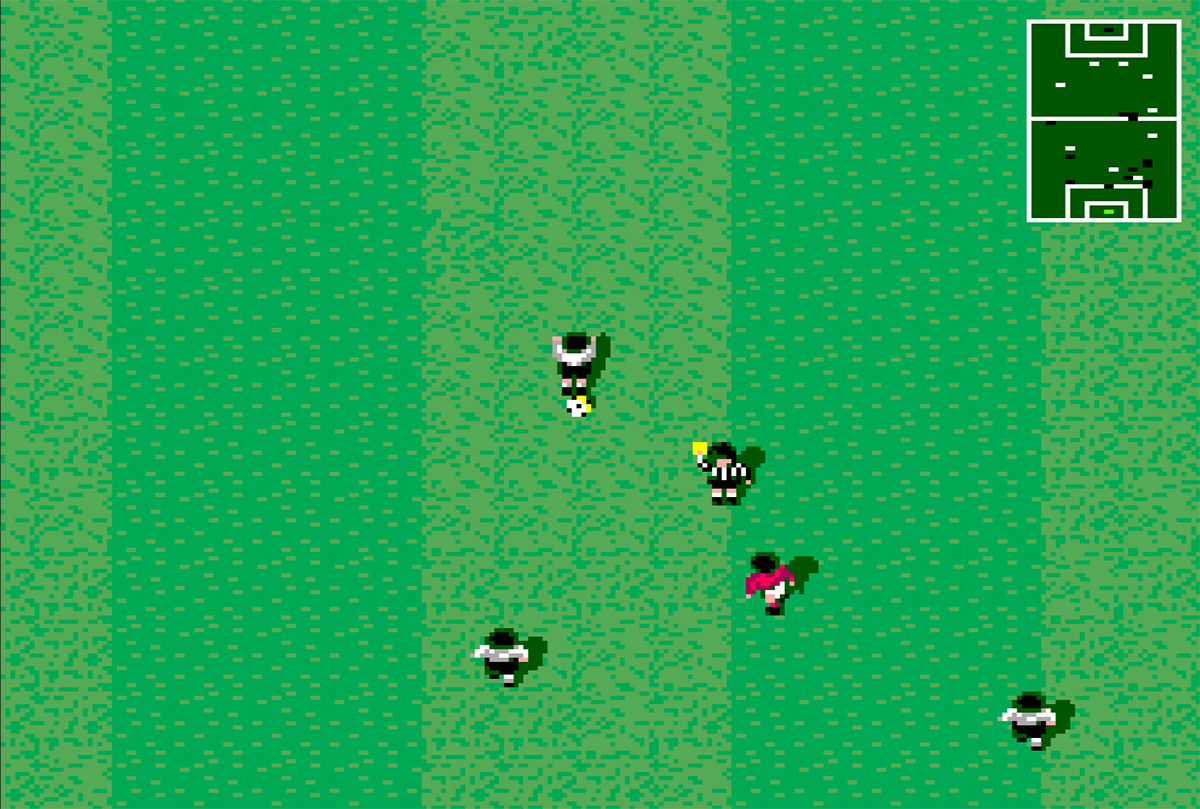
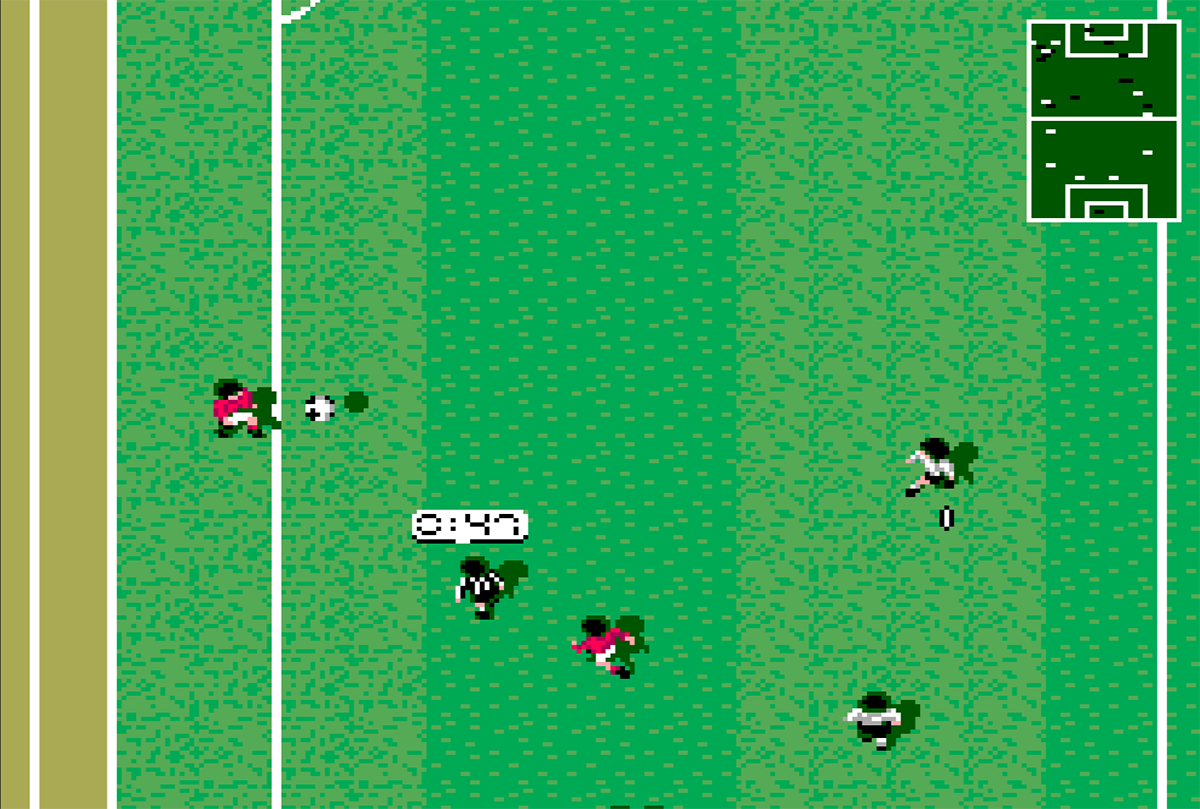
Tackling is done by pressing button 1 if you don’t have the ball, but more often than not it results in a foul or the player sliding half way across the pitch. As mentioned earlier, you can pick your referee. It doesn’t appear to matter what ref you choose as their strictness appears to be more down to what mood they’re in rather than who it is. Sometimes they are quite lenient and let some fouls go unnoticed, but other times they stop the match at the slightest hint of a player even thinking about going near to an opponent. It results in the game being stopped every few seconds. And restarting the game from any stoppage seems to take a stupid length of time too. Sometimes you have to wait until the ref has given out a card, other times a player goes off injured and you have to wait for him to leave the pitch and his replacement to make an appearance. If a corner or goal kick is about to be taken, it’s a case of waiting until all players have got themselves into position before play resumes. It’s just needlessly frustrating. The ref also seems obsessed with telling you the time too throughout the match, although this does serve a useful purpose.
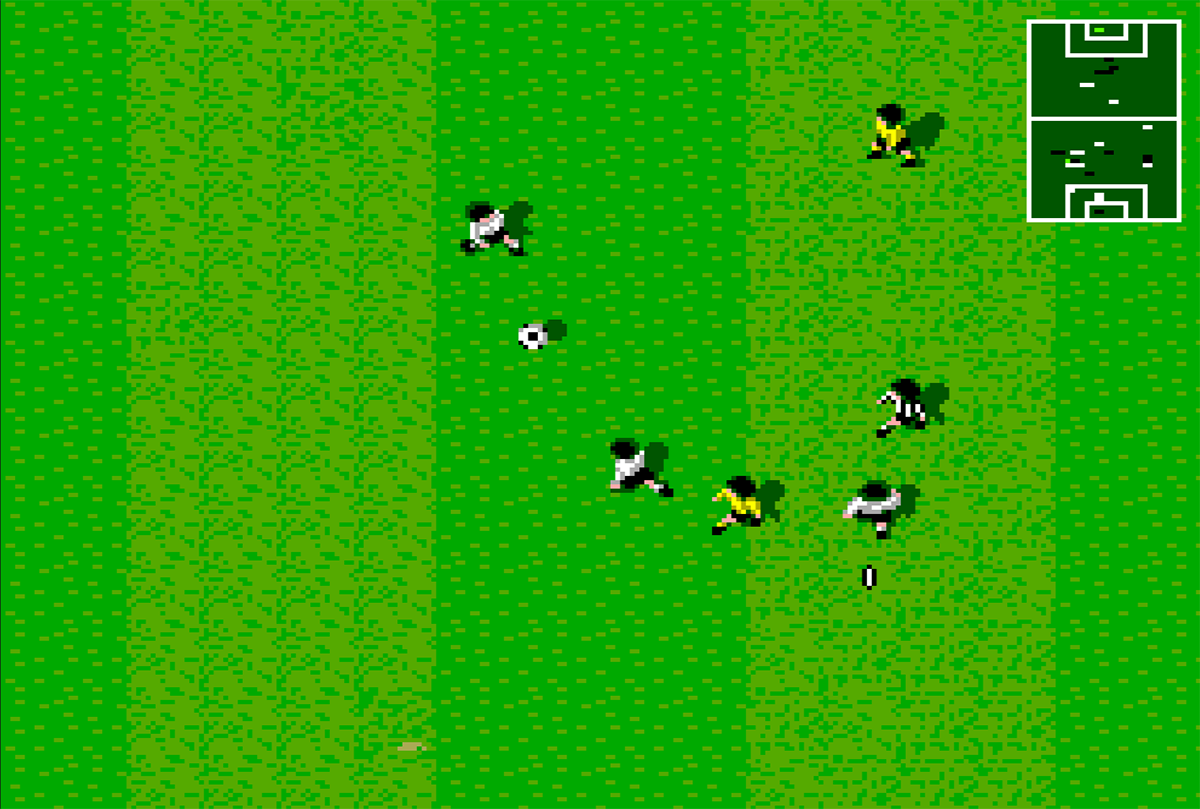
Button 2 allows you to sprint if you don’t have the ball, but causes the problem of you approaching it too quickly so when you do get to it, you knock it miles forward to nobody. If you have the ball, you can use button 2 to shoot. If you’ve got aftertouch on, you can also direct the curve of the shot afterwards. Pressing both buttons at the same time changes the team formation. Again, completely pointless as it feels that half your team aren’t even on the pitch anyway so it makes little difference defining where they’re meant to be positioned.
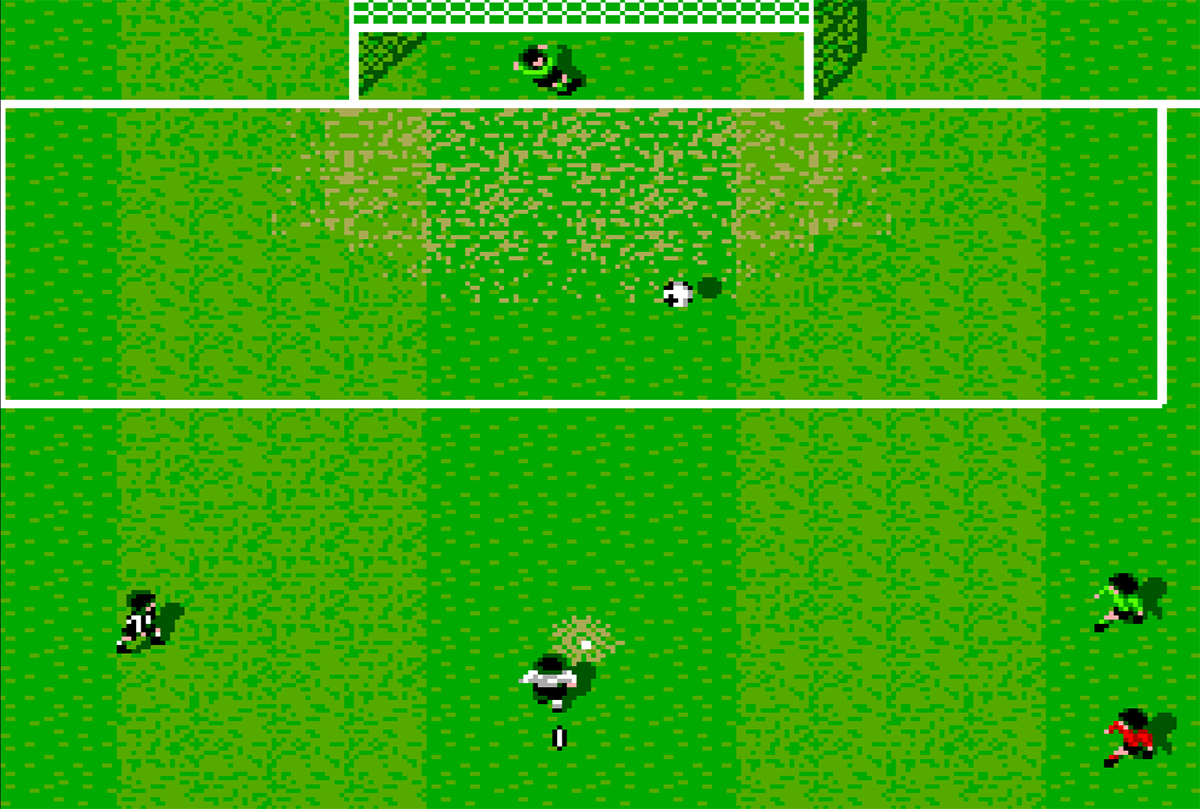
The main problem with the game is that it just doesn’t feel like you’ve actually got any control of it at all. If you manage to dribble or pass the ball, make a successful tackle or even score a goal, it feels like it’s more down to pure luck than the involvement of any gamesplaying skill. That’s possibly with the exception of if you use aftertouch which does give you a bit of influence on goalscoring. Throw-ins, free kicks and goalkeeper kicks are semi-automated, as are saving penalties. With the latter, you do get to choose which direction to send your goalkeeper in, but whether he saves it or not largely depends on whether he feels like it.
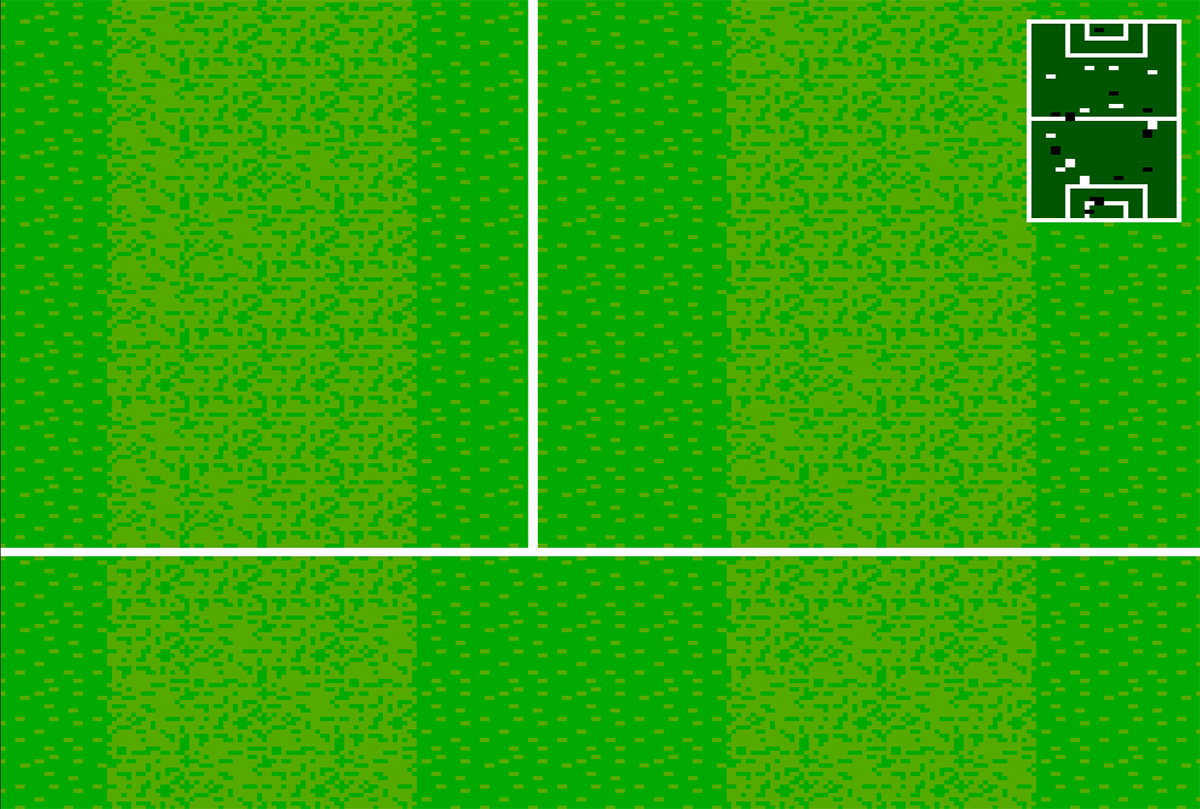
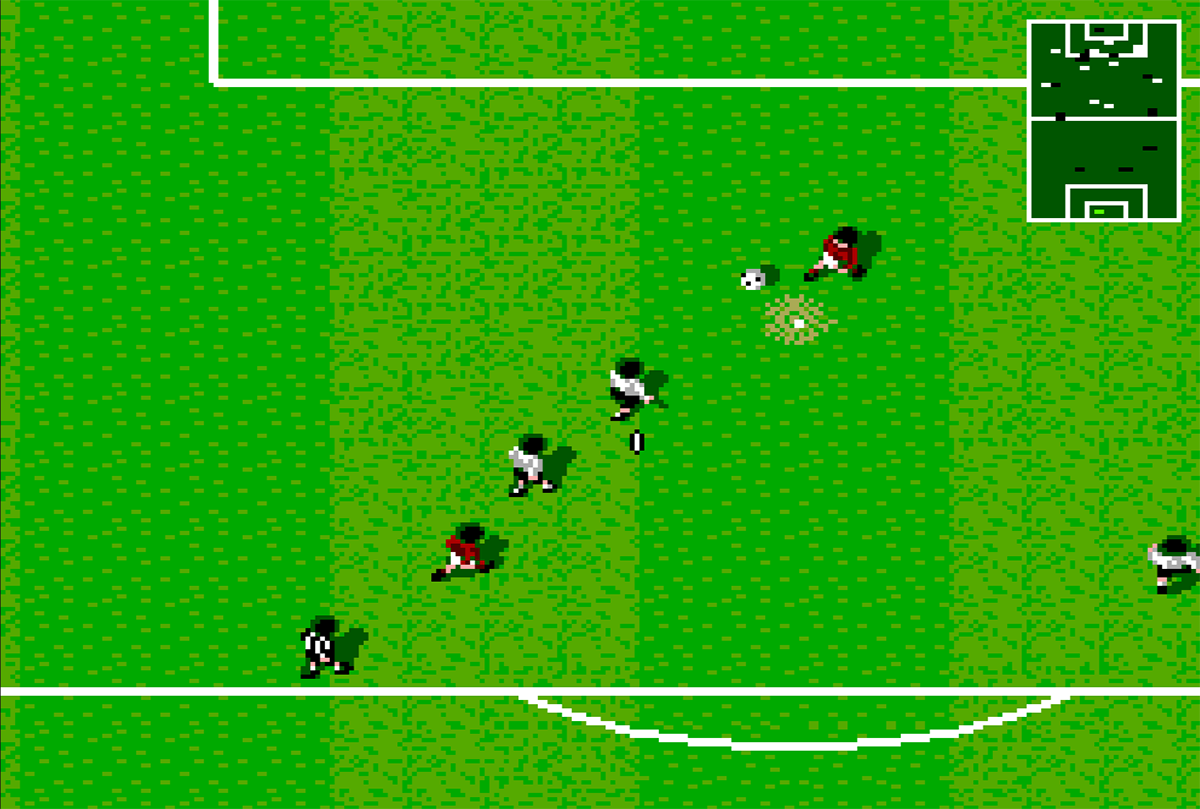
The game isn’t too bad to look at, especially if you’re a fan of digital depictions of grass. Oooh, that’s another idea for a new feature – grass in video games. I’ll put it to the powers that be sometime. The pitch in Champions of Europe appears to be well-tended with its dark and light horizontal strips running the length of it and the turf seems suitably worn around the goalmouth areas, centre spot and penalty spots. If you choose to play in the rain, it becomes more of a turquoise color, as that’s apparently what happens when grass gets wet in Champions of Europe land. Players are well illustrated, it’s clear to see which way they’re facing and you can see their little legs and arms moving as they run around aimlessly. They all have a little shadow too showing that there is more than two dimensions to them. The introductory screen and menus with icons are easy on the eye too, with the map of Europe being the only bit that looks like it could have done with a bit more work.
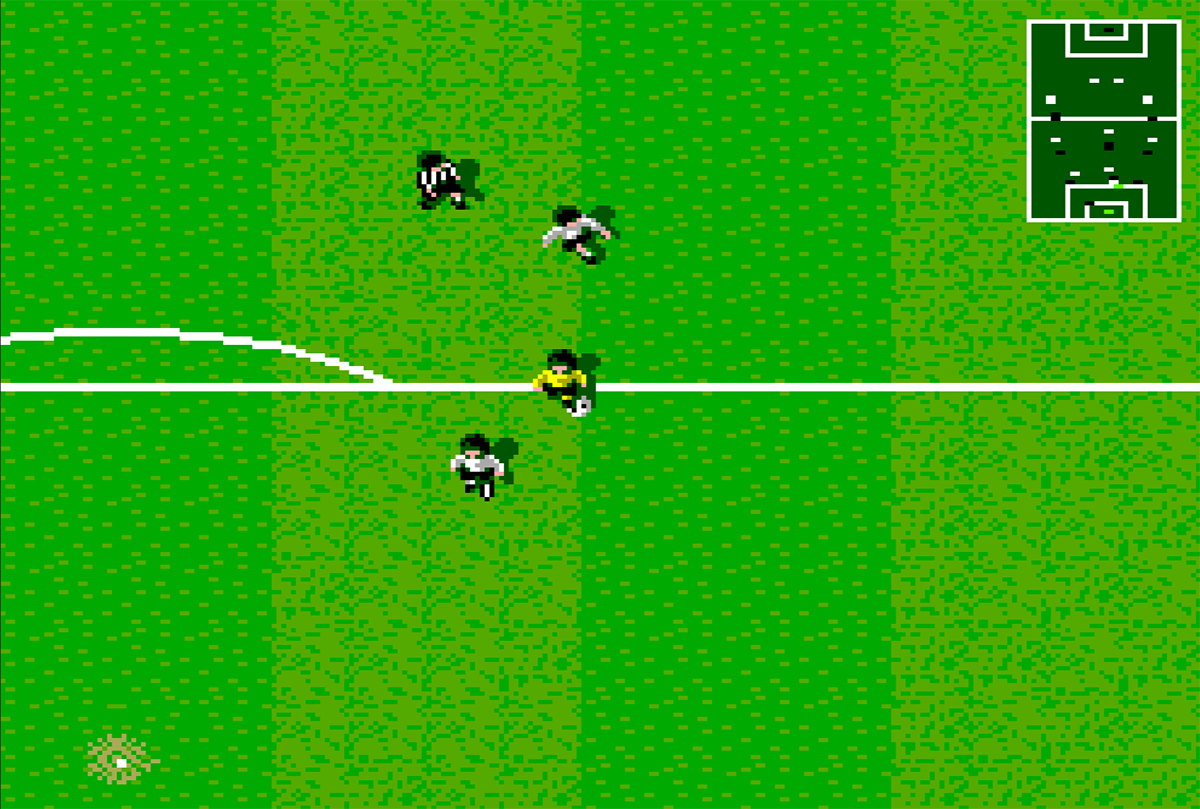
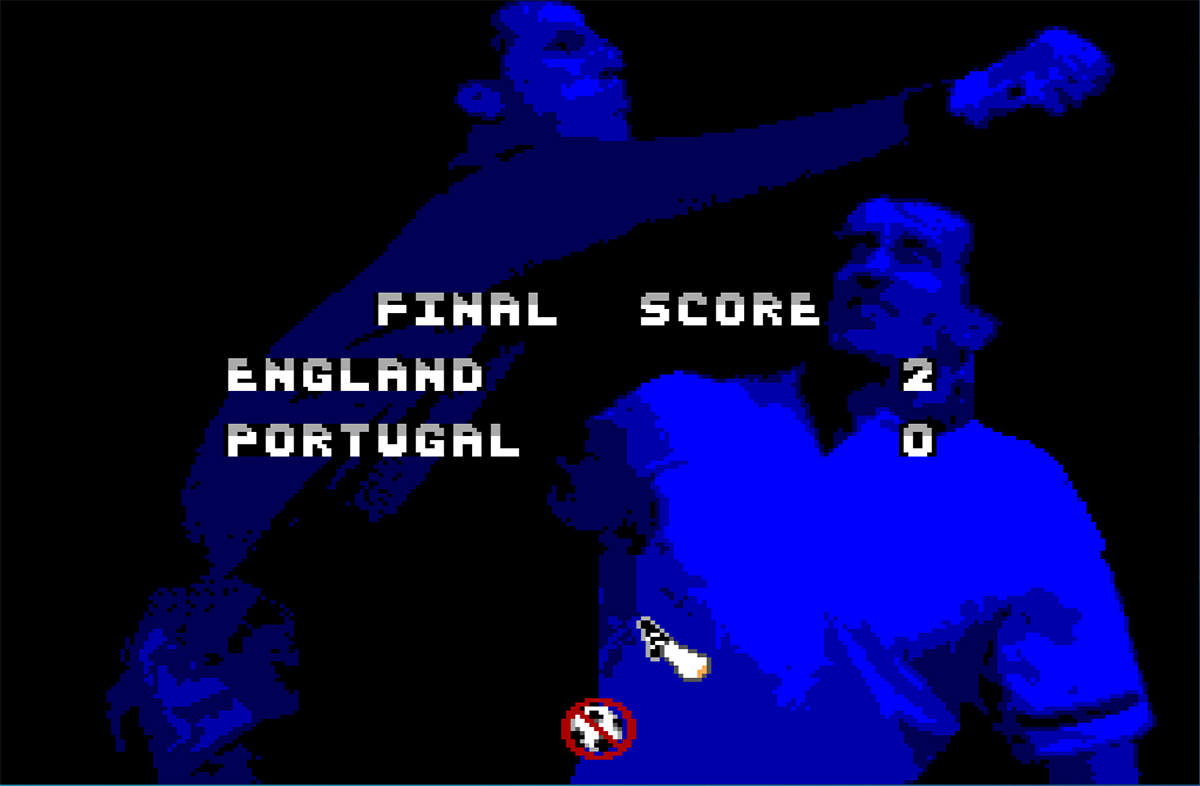
Missing in the game though is any sign of a crowd or advertising boards so you don’t get the sense of being in a stadium. You could be playing in the middle of anywhere. As it’s meant to be an event game, it would have been nice for it to capture the occasion. Overall presentation is quite minimal too. Before a match starts, the team names are displayed on screen, but maybe a flag to represent them would have been nice too. At half time and after the game, the team names appear again but with the score alongside them too. Handy stuff. During the game, there are no overlays featuring the time or score, with only the radar taking up one of the corners of the screen if you’ve decided not to switch it off. Keeping you informed as to how much longer you have to put up with the torture is the referee who shouts out the remaining time via the medium of a speech bubble. He also declares corners, goal kicks, fouls and so on through the same means. Players also occasionally yell out in pain, anger, joy or frustration through their own speech bubbles too. It’s quite a good way of doing it.
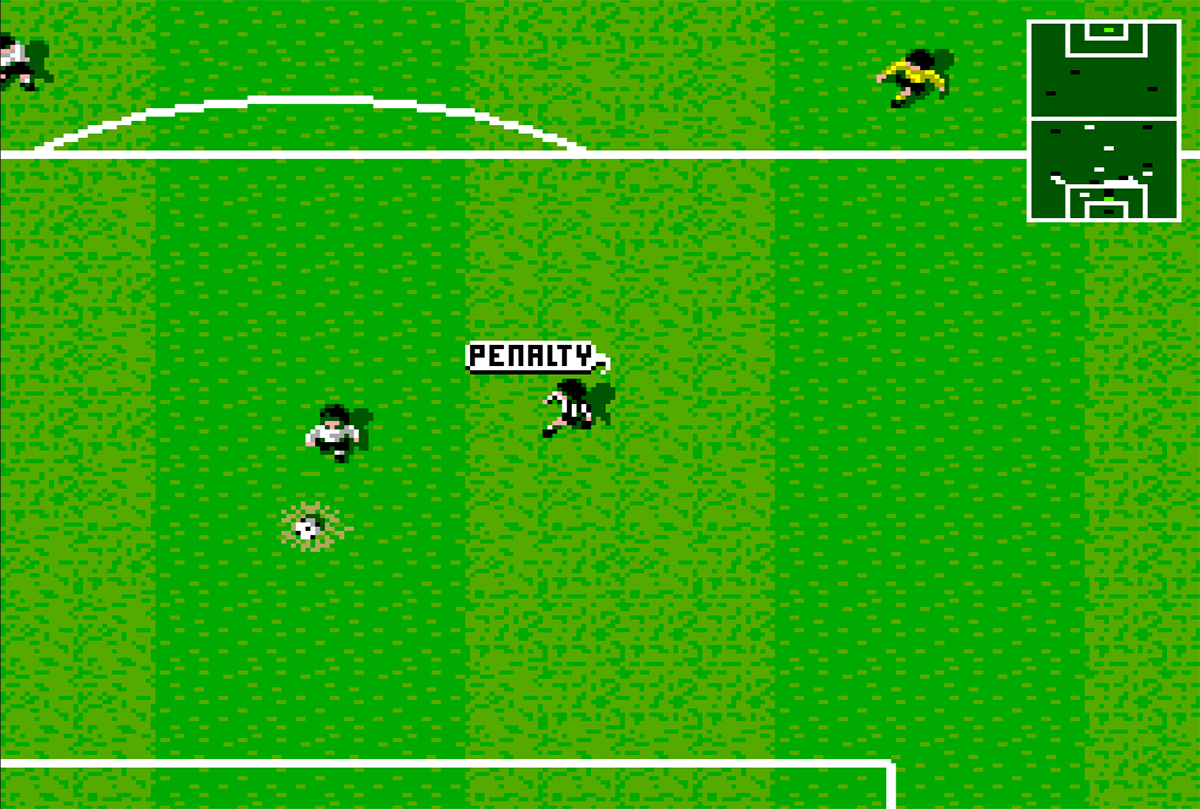
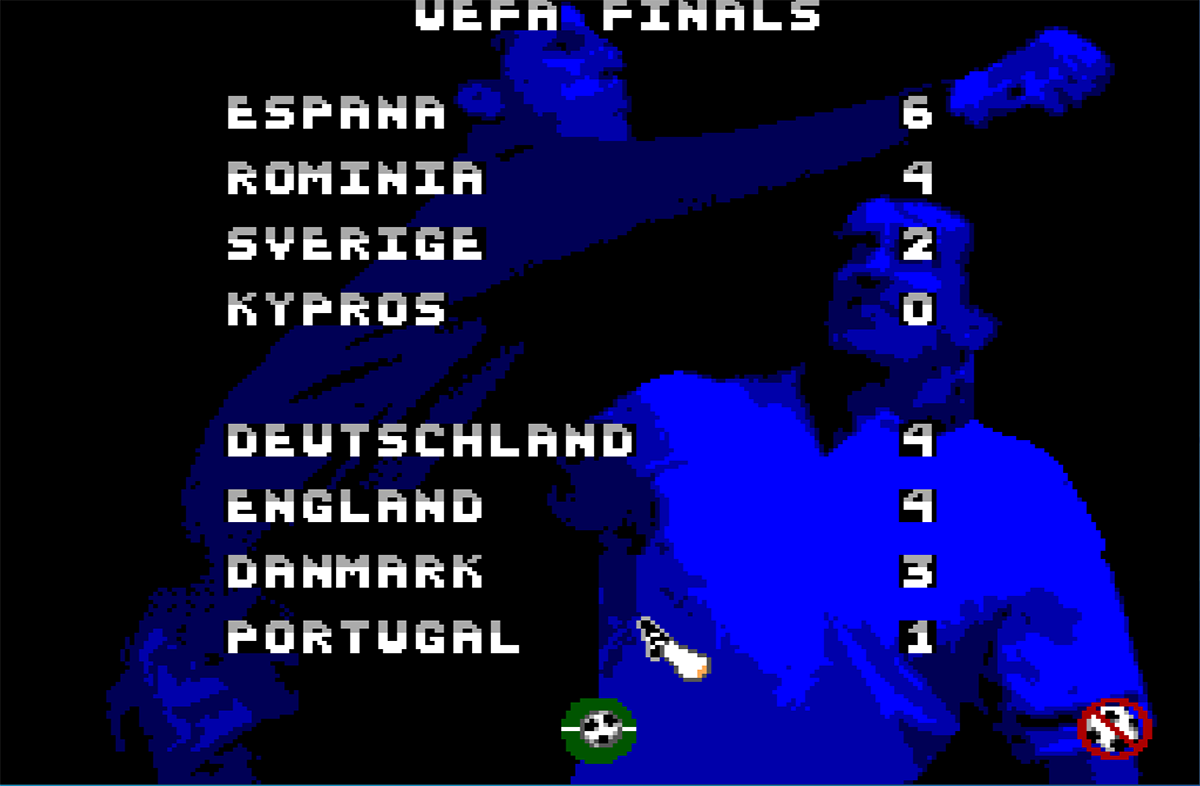
As for sound, there’s not a lot to it. Apart from the title screen music, it’s rather minimal elsewhere. The ref blows a whistle at the appropriate times, and the ball makes a faint tapping noise when bouncing along the pitch or a thud if kicked harder. There is no crowd noise, even after the scoring of a goal, which adds to the feeling that the action isn’t being played in a stadium in front of an audience of thousands of excitable football fans. Menu screens and those that pop up pre, mid and post-game are totally silent affairs.
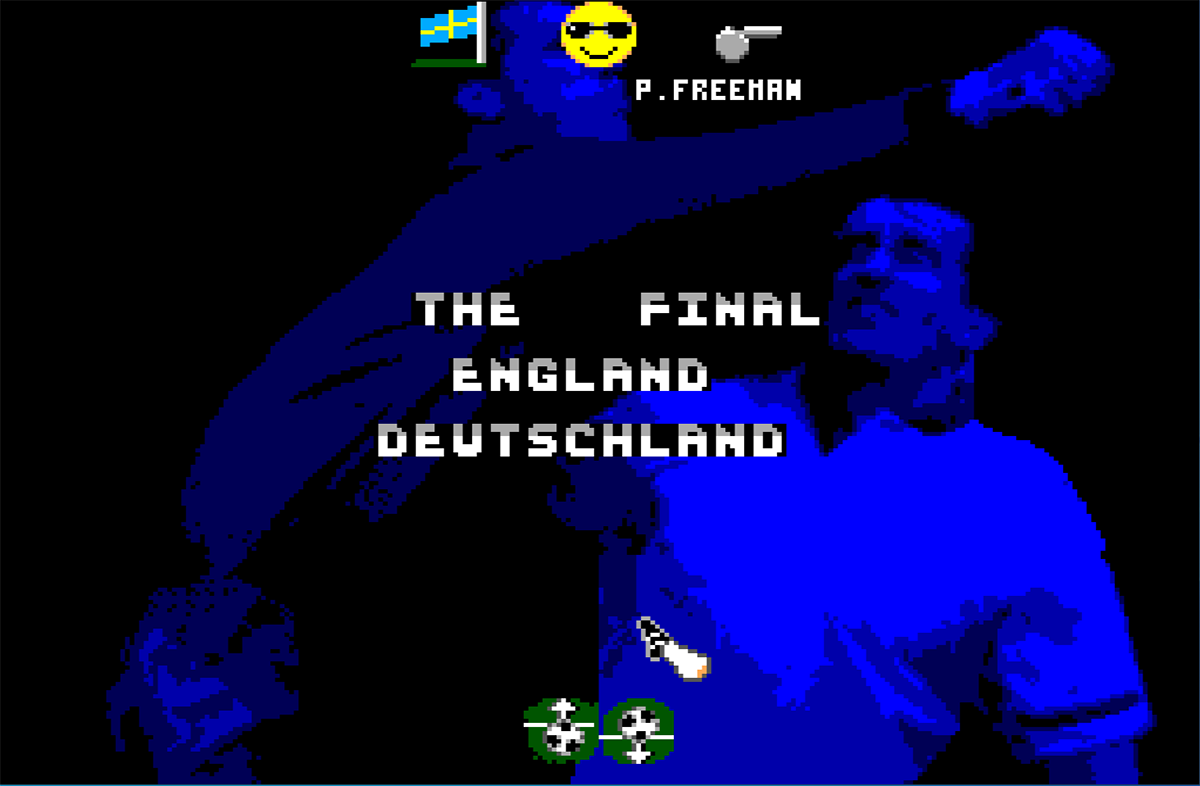
That’s probably the game’s defining feature – its complete lack of atmosphere. Well, in addition to it being a total pig to play. It’s about as barebones as a game can be – even the players don’t have names. It doesn’t matter if they’re fake ones bearing some sort of similarity to a real person, anything would have been better than nothing. It would be nice to know who has committed a foul or the names of the goal scorers. It makes no difference to the gameplay overall, but would add a little extra to it. Changing settings like wind, weather or referee doesn’t really appear to have an actual bearing on the game itself. Even if you win the cup in tournament mode, you are rewarded with a static screen and piece of music which sounds like it’s made up of a series of random notes. Hardly what you’d expect after waiting four years to be able to compete in the finals. And after you’ve won the cup, you’ll probably never want to come back to it again. It’s just not an enjoyable experience. The whole thing just feels like a Super Kick Off wannabe, rushed out to cash in on the Euros.
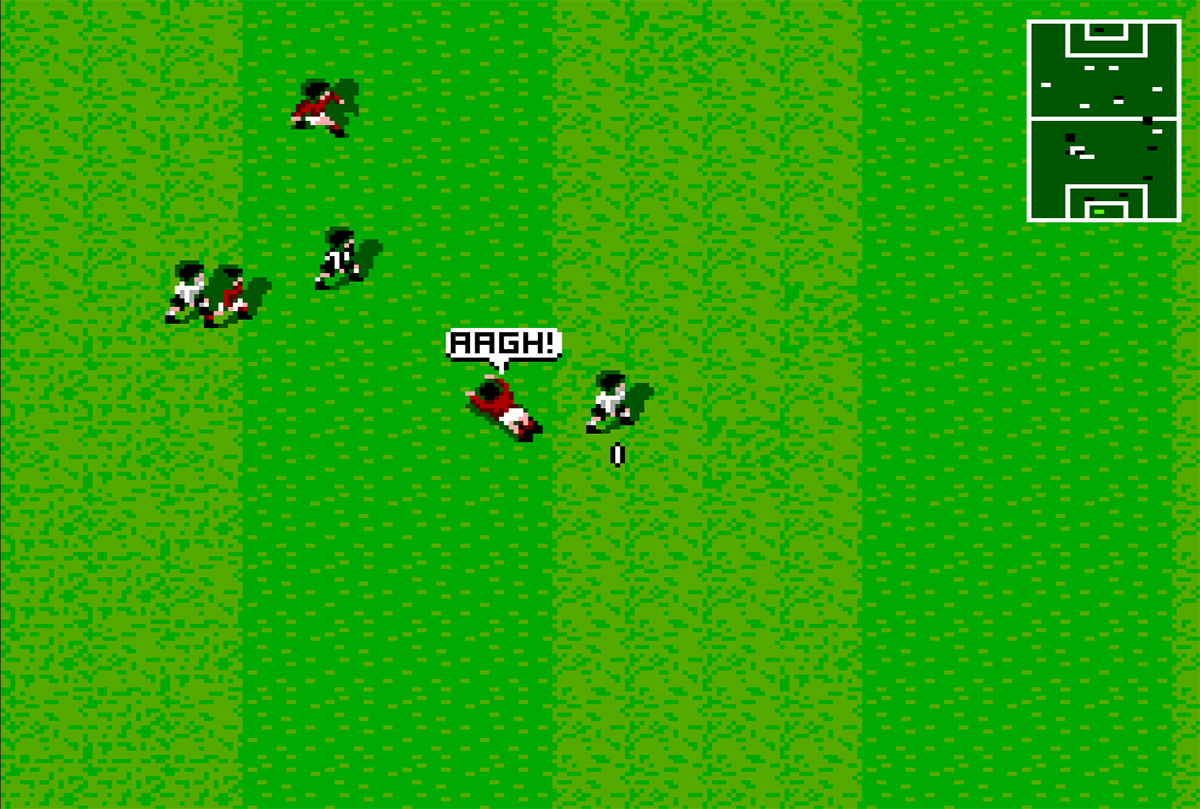
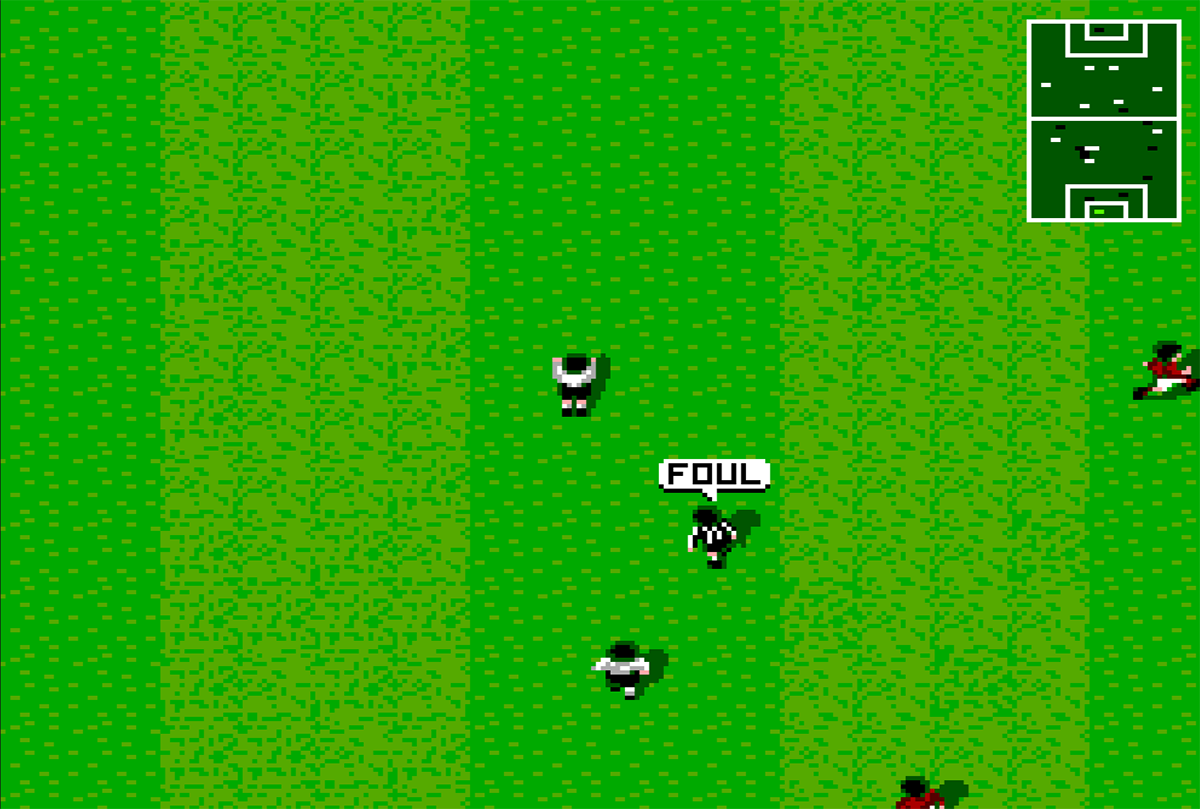
While the game is devoid of playability and atmosphere, one thing it does contain are bugs and a general lack of attention to detail. If you’re winning a game at half time and don’t fancy the idea of giving your opponent a chance to get a goal or two back, just quit and it’ll still go down as a win. This is especially handy in tournament mode as you get given the two points that were awarded for a win back in Euro ’92. If a game goes into extra time, rather than playing two shorter halves, you have to endure two more full-length halves. Back in the day, it was reported that scoring a goal into your own net would count it as a goal for yourself. Although I attempted to replicate this while playing the game for this review, both own goals that I scored did still go to the opposition. However, while recording the playthrough video for YouTube, a goal that I legitimately scored was awarded to the opposition. Even worse, it should have been the winning goal in the final! I was robbed. How TecMagik could charge the £30 or whatever it was back then for a football game that doesn’t even know how to keep score is bewildering.
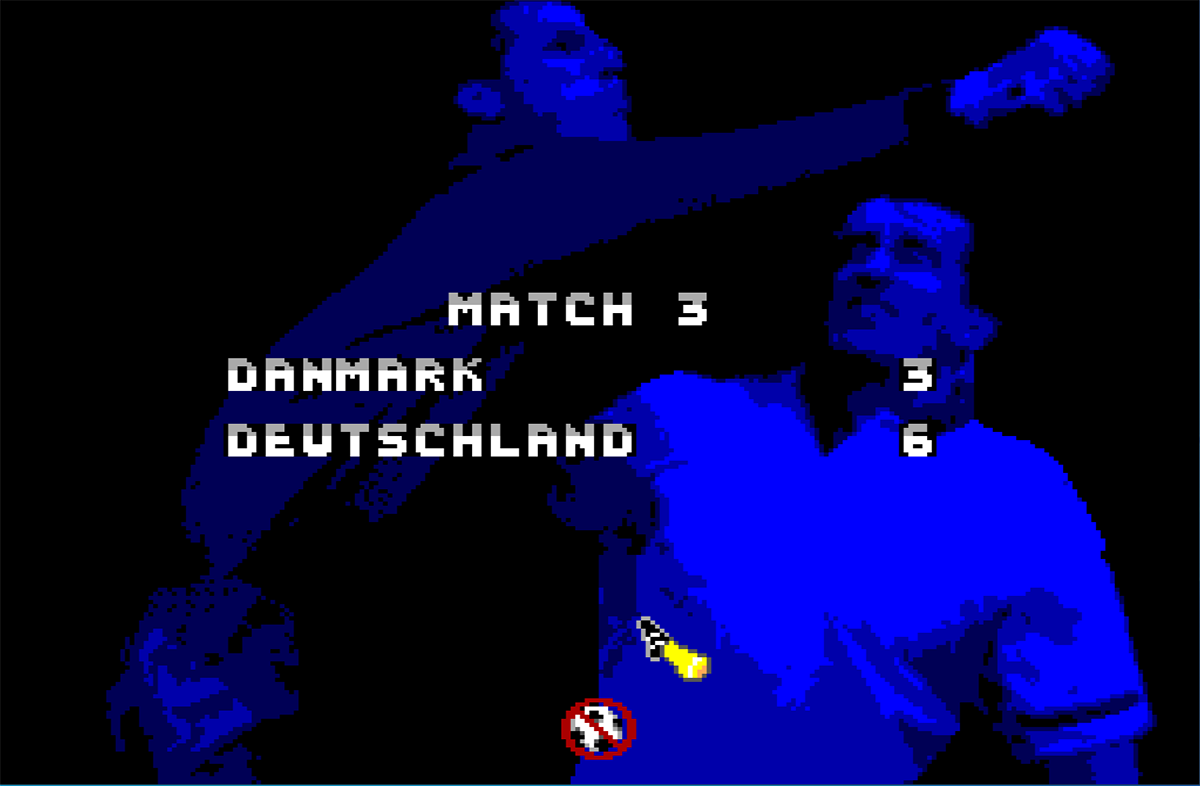
Bugs aside, even little things like when you’re viewing the scores of other teams in the tournament, you have to hit a button to go to the next screen. But rather than the cursor you’re using hovering over the relevant button (the only one on the screen!), its position resets itself, so you have to move it back to the button again. Again, it’s just little annoyances like that which should have been ironed out with a bit of playtesting. And why all the scores couldn’t just appear on one screen, I don’t know.
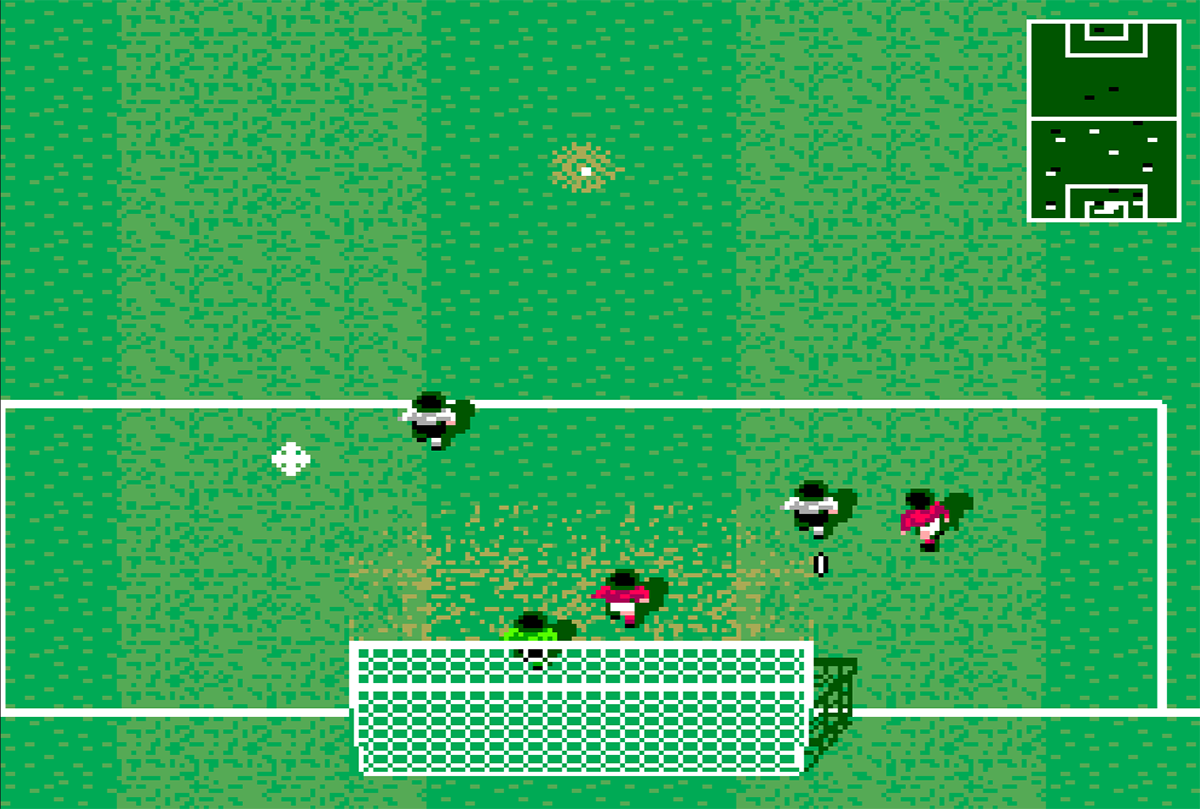
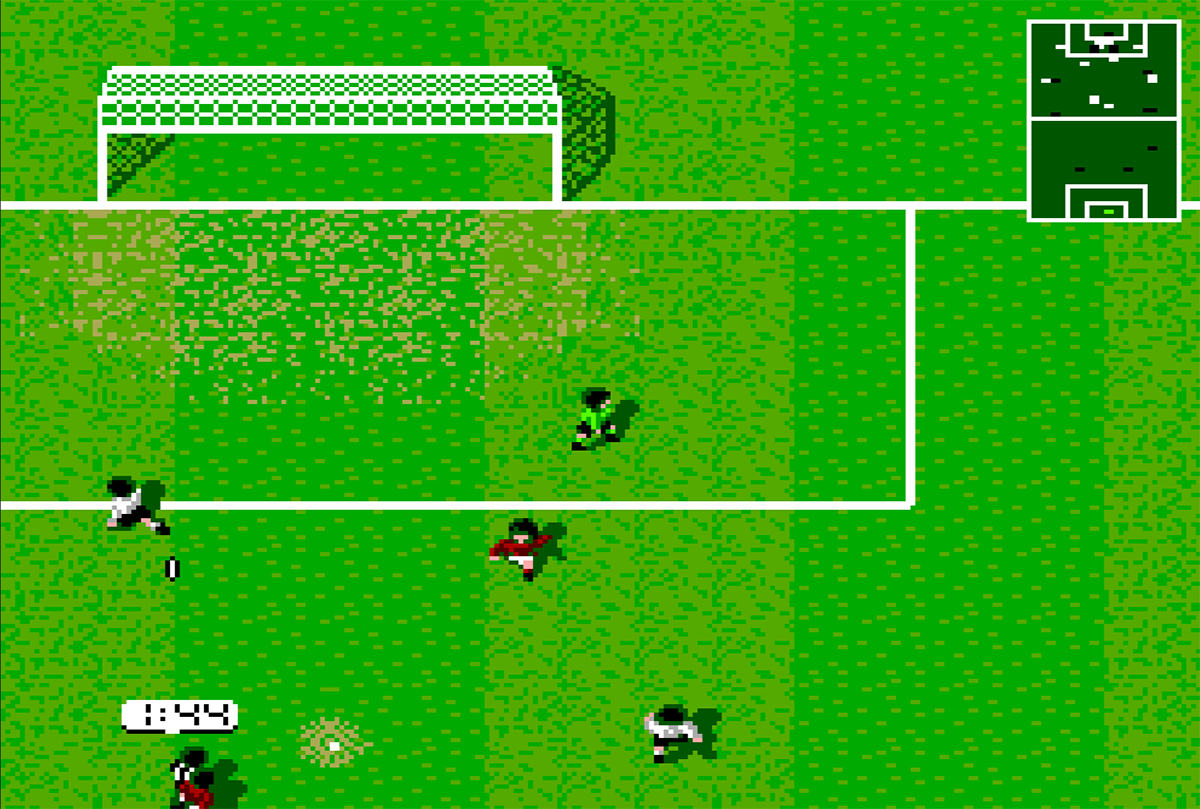
As mentioned earlier, the game reviewed really well at the time. TecMagik had a bit of a reputation for putting out quality games for the Master System, mostly conversions of other titles. Populous, Pac-Mania, The New Zealand Story and Shadow of the Beast were all excellent on the console. Maybe this reputation caused game journalists to look at them more favourably, believing them not to be capable of dropping the ball and scoring an own goal. Sega Force gave it 91% in a review where they claimed that “manoeuvring players is a real doddle.” Suspiciously, the page straight after the review featured a competition being run in association with TecMagik. Hmmm. Over in Sega Pro, they reckoned it was worthy of 92% and was the “best ever soccer game on the Master System.” After reading those reviews, I was concerned that, somehow, I just hadn’t figured out how to play the game and I was actually missing out on something special. Reassuring me that I’m not completely crazy is Sega Power’s review, which reflects my feelings about that the game much more closely. It’s described as an “unplayable nightmare from the kick-off to the final whistle” and scored a lowly 27%. Yes, that’s more like it.
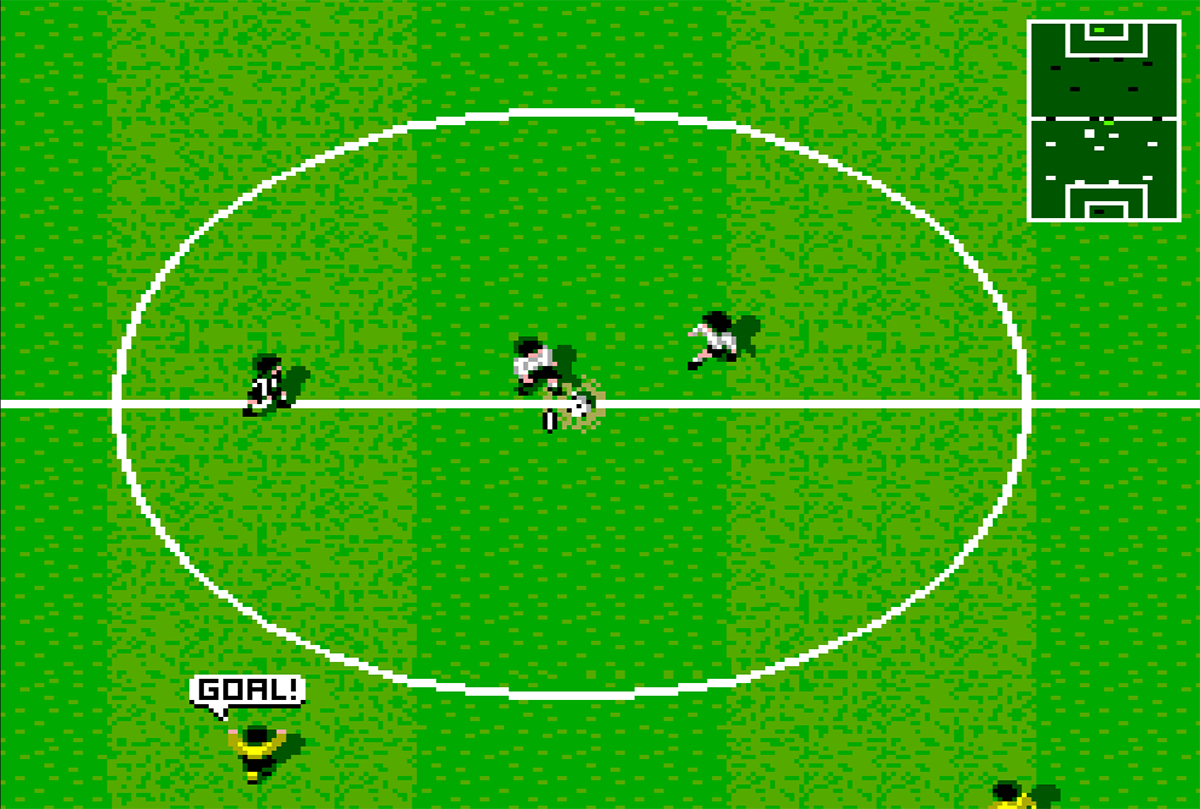
So, if you’re looking for a way of experiencing the thrills and spills of this year’s European tournament for yourself, stay well away from Champions of Europe. It really is a depressing and dire game with broken controls and unforgiveable bugs. Do I not like that!
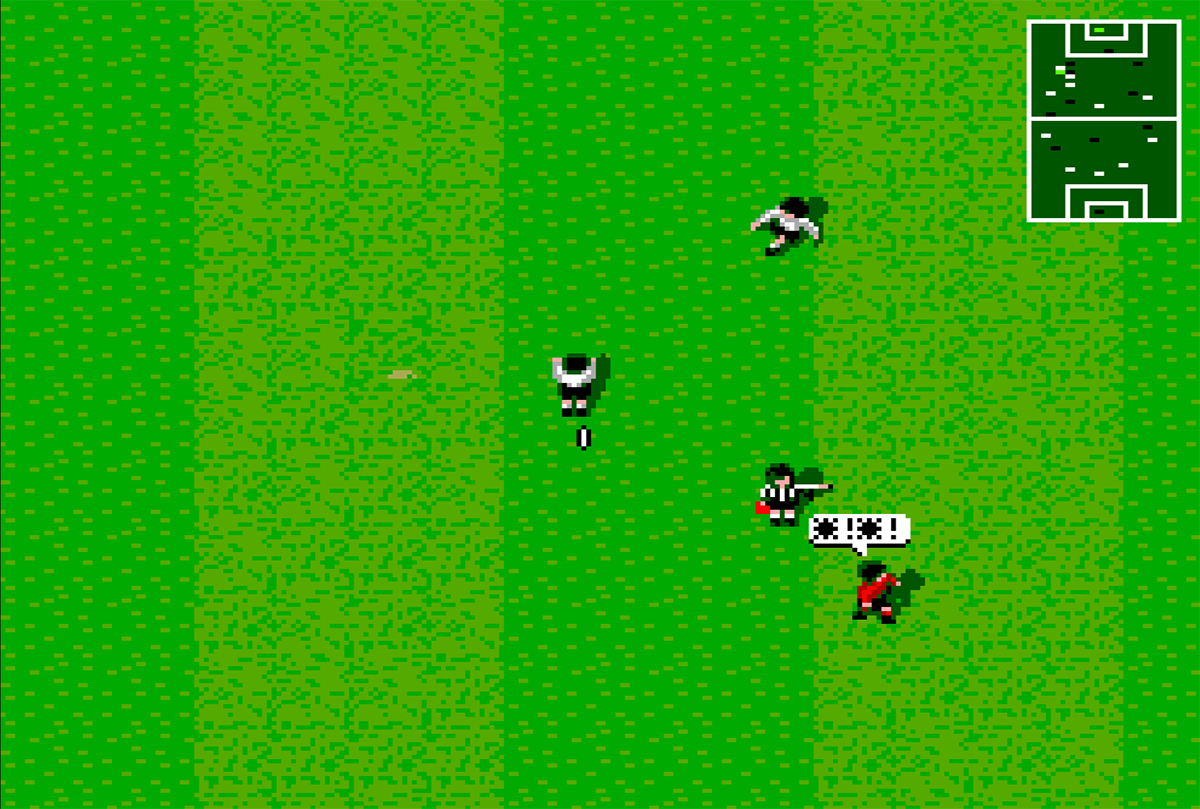
"Champions of Europe is the most playable and visually exciting game on any Sega, and if that recommendation enough to buy it, you need your head examining."
Sega Force (UK, June 1992): 93%
"Champions of Europe's far from boring and will make Mega Drive owners everywhere green with envy 'cos there 'ain't a decent 16-bit soccer game around. Congratulations, TecMagik, you've netted a good 'un here!"
Game Zone (UK, June 1992): 88%
"Champions of Europe is an excellent footie game, it's not a bad European Championship game either. It's impossible to avoid the Kick Off comparison. In some respects, Champions of Europe is better. If you've already got Kick Off it isn't different enough to make it worth buying as well. However if you haven't got Kick Off then check this out!"
Sega Power (UK, September 1992): 27%
"What an incredibly awful game! Anyone who even contemplates paying £35 for this pile of nob should put themselves in for a frontal lobotomy NOW! Steer well clear."


